Arcadyan Technology WA6001AARC 3Com OfficeConnect Wireless 11a/b/g Access Point User Manual
Arcadyan Technology Corporation 3Com OfficeConnect Wireless 11a/b/g Access Point
User Manual

http://www.3com.com/
Part No. DUA0045-4AAA02
Rev. 01
Published July 2003
OfficeConnect®
Wireless 11a/b/g Access Point
User Guide
3CRWE454A72
3Com Corporation
5500 Great America
Parkway
Santa Clara, California
95052-8145
Copyright © 2003, 3Com Corporation. All rights reserved. No part of this documentation may be reproduced in any
form or by any means or used to make any derivative work (such as translation, transformation, or adaptation)
without written permission from 3Com Corporation.
3Com Technologies reserves the right to revise this documentation and to make changes in content from time to time
without obligation on the part of 3Com Technologies to provide notification of such revision or change.
3Com Corporation provides this documentation without warranty, term, or condition of any kind, either implied or
expressed, including, but not limited to, the implied warranties, terms or conditions of merchantability, satisfactory
quality, and fitness for a particular purpose. 3Com may make improvements or changes in the product(s) and/or the
program(s) described in this documentation at any time.
If there is any software on removable media described in this documentation, it is furnished under a license agreement
included with the product as a separate document, in the hard copy documentation, or on the removable media in a
directory file named LICENSE.TXT or !LICENSE.TXT. If you are unable to locate a copy, please contact 3Com and
a copy will be provided to you.
UNITED STATES GOVERNMENT LEGEND
If you are a United States government agency, then this documentation and the software described herein are
provided to you subject to the following:
All technical data and computer software are commercial in nature and developed solely at private expense. Software
is delivered as “Commercial Computer Software” as defined in DFARS 252.227-7014 (June 1995) or as a
“commercial item” as defined in FAR 2.101(a) and as such is provided with only such rights as are provided in
3Com’s standard commercial license for the Software. Technical data is provided with limited rights only as provided
in DFAR 252.227-7015 (Nov 1995) or FAR 52.227-14 (June 1987), whichever is applicable. You agree not to remove
or deface any portion of any legend provided on any licensed program or documentation contained in, or delivered to
you in conjunction with, this User Guide.
Unless otherwise indicated, 3Com registered trademarks are registered in the United States and may or may not be
registered in other countries.
3Com, OfficeConnect and the 3Com logo are registered trademarks of 3Com Corporation.
Intel and Pentium are registered trademarks of Intel Corporation. Microsoft, MS-DOS, Windows, and Windows NT
are registered trademarks of Microsoft Corporation. Novell and NetWare are registered trademarks of Novell, Inc.
UNIX is a registered trademark in the United States and other countries, licensed exclusively through X/Open
Company, Ltd.
Netscape Navigator is a registered trademark of Netscape Communications.
JavaScript is a trademark of Sun Microsystems
Wi-Fi and the Wi-Fi logo are trademarks of WECA (Wireless Ethernet Compatibility Alliance)
IEEE and 802 are trademarks of the Institute of Electrical and Electronics Engineers, Inc.
All other company and product names may be trademarks of the respective companies with which they are
associated.
ENVIRONMENTAL STATEMENT
It is the policy of 3Com Corporation to be environmentally-friendly in all operations. To uphold our policy, we are
committed to:
Establishing environmental performance standards that comply with national legislation and regulations.
Conserving energy, materials and natural resources in all operations.
Reducing the waste generated by all operations. Ensuring that all waste conforms to recognized environmental
standards. Maximizing the recyclable and reusable content of all products.
Ensuring that all products can be recycled, reused and disposed of safely.
Ensuring that all products are labelled according to recognized environmental standards.
Improving our environmental record on a continual basis.
End of Life Statement
3Com processes allow for the recovery, reclamation and safe disposal of all end-of-life electronic components.
Regulated Materials Statement
3Com products do not contain any hazardous or ozone-depleting material.
Environmental Statement about the Documentation
The documentation for this product is printed on paper that comes from sustainable, managed forests; it is fully
biodegradable and recyclable, and is completely chlorine-free. The varnish is environmentally-friendly, and the inks
are vegetable-based with a low heavy-metal content.

CONTENTS
ABOUT THIS GUIDE
Naming Convention 7
Conventions 8
Feedback about this User Guide 8
Related Documentation 9
Product Registration 9
1INTRODUCING THE ACCESS POINT
OfficeConnect Wireless 11g Access Point 12
Access Point Advantages 13
Package Contents 13
Minimum System and Component Requirements 14
Front Panel 14
Rear Panel 16
2HARDWARE INSTALLATION
Introduction 17
Safety Information 17
Positioning the Access Point 17
Using the Rubber Feet 18
Wall Mounting 18
Powering Up the Access Point 19
Connecting the Access Point 19
3RUNNING THE SETUP WIZARD
Accessing the Wizard 21
Password 26
LAN Settings 26
Wireless Settings 28
Summary 30

4ACCESS POINT CONFIGURATION
Navigating Through the Access Point Configuration Pages 31
Main Menu 31
Option Tabs 32
Welcome Screen 32
Notice Board 33
Password 33
Wizard 34
LAN Settings 34
Unit Configuration 34
DHCP Clients List 38
Wireless Settings 39
Configuration 39
Encryption 41
Configuring WPA Encryption 41
Configuring WEP Encryption 42
Connection Control 44
Client List 47
Profile 48
System Tools 50
Restart 50
Configuration 50
Upgrade 51
Status and Logs 53
Status 54
Logs 54
Support and Feedback 54
5CLIENT BRIDGE MODE CONFIGURATION
What is Client Bridge Mode? 57
Switching to Client Bridge Mode 57
Configuring Client Bridge Mode 58
Welcome Menu 58
LAN Settings 59
Wireless Settings 59
Configuration 60
Encryption 60

Restart 63
Status and Logs 63
Support and Feedback 63
6TROUBLESHOOTING
Basic Connection Checks 65
Browsing to the Access Point Configuration Screens 65
Forgotten Password and Reset to Factory Defaults 66
Wireless Networking 66
Alert LED 68
Recovering from Corrupted Software 68
Frequently Asked Questions 69
AUSING DISCOVERY
Running the Discovery Application 71
Windows Installation (95/98/2000/Me/NT) 71
BIP ADDRESSING
The Internet Protocol Suite 73
Managing the Access Point over the Network 73
IP Addresses and Subnet Masks 73
How does a Device Obtain an IP Address and Subnet Mask? 75
DHCP Addressing 75
Static Addressing 75
Auto-IP Addressing 75
CTECHNICAL SPECIFICATIONS
Standards 78

DSAFETY INFORMATION
EEND USER SOFTWARE LICENSE AGREEMENT
GLOSSARY
INDEX
REGULATORY NOTICES FOR THE WIRELESS 11G ACCESS
POINT

ABOUT THIS GUIDE
This guide describes how to install and configure the OfficeConnect Wireless
11a/b/g Access Point (3CRWE454A72).
This guide is intended for use by those responsible for installing and setting up
network equipment; consequently, it assumes a basic working knowledge of
LANs (Local Area Networks).
If a release note is shipped with the OfficeConnect Wireless 11a/b/g Access
Point and contains information that differs from the information in this guide,
follow the information in the release note.
Most user guides and release notes are available in Adobe Acrobat Reader
Portable Document Format (PDF) on the 3Com World Wide Web site:
http://www.3com.com
Naming Convention Throughout this guide, the OfficeConnect Wireless 11a/b/g Access Point is
referred to as the “Access Point”.
Category 3 and Category 5 Twisted Pair Cables are referred to as Twisted Pair
Cables throughout this guide.
The PC used to configure the Access Point is referred to as the “admin
computer”. 3Com recommends that during the initial configuration that this is
connected to the same switch or hub as the Access Point.
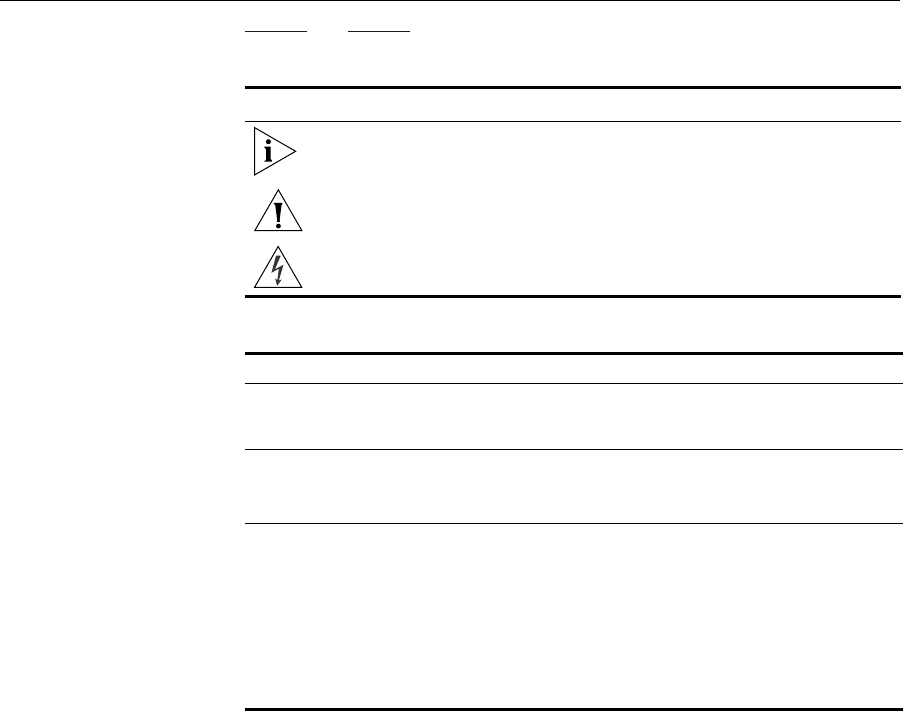
8ABOUT THIS GUIDE
Conventions Table 1 and Table 2 list conventions that are used throughout this guide.
Feedback about this
User Guide Your suggestions are very important to us. They will help make our
documentation more useful to you. Please e-mail comments about this
document to 3Com at:
pddtechpubs_comments@3com.com
Please include the following information when commenting:
■Document title
■Document part number (on the title page)
■Page number (if appropriate)
Table 1 Notice Icons
Icon Notice Type Description
Information note Information that describes important features or
instructions.
Caution Information that alerts you to potential loss of data or
potential damage to an application, system, or device.
Warning Information that alerts you to potential personal injury.
Table 2 Text Conventions
Convention Description
The words “enter”
and “type” When you see the word “enter” in this guide, you must type
something, and then press Return or Enter. Do not press Return or
Enter when an instruction simply says “type.”
Keyboard key names If you must press two or more keys simultaneously, the key
names are linked with a plus sign (+). Example:
Press Ctrl+Alt+Del
Words in italics Italics are used to:
■Emphasize a point.
■Denote a new term at the place where it is defined in the text.
■Identify menu names, menu commands, and software button
names. Examples:
From the Help menu, select Contents.
Click OK.

Conventions 9
Example:
■OfficeConnect Wireless 11a/b/g Access Point User Guide
■Part Number DUA0045-4AAA02
■Page 24
Do not use this e-mail address for technical support questions. For
information about contacting Technical Support, please refer to the Support
and Safety Information sheet.
Related Documentation In addition to this guide, each Access Point document set includes one
Installation Guide. This guide contains the instructions you need to install and
configure your Access Point.
Product Registration You can now register your Access Point on the 3Com web site and receive
up-to-date information on your product:
http://www.3com.com/register/
10 ABOUT THIS GUIDE
1INTRODUCING THE ACCESS
POINT
Welcome to the world of networking with 3Com®. In the modern business
environment, communication and sharing information is crucial. Computer
networks have proved to be one of the fastest modes of communication but,
until recently, only large businesses could afford the networking advantage.
The OfficeConnect®product range from 3Com has changed all this, bringing
networks to the small office.
The products that compose the OfficeConnect range give you, the small office
user, the same power, flexibility, and protection that has been available only to
large corporations. Now, you can harness the benefits of wireless networking.

12 CHAPTER 1: INTRODUCING THE ACCESS POINT
OfficeConnect
Wireless 11g Access
Point
The OfficeConnect Wireless 11a/b/g Access Point is designed to provide a
cost-effective means of connecting wired and wireless networks.
A single Access Point makes the Internet, e-mail and network resources, such
as printers, available to dozens of wireless clients. Because the Access Point is
a WI-FI certified device, you can be sure it will work reliably with certified
equipment from other manufacturers.
Figure 1 Example Network
3Com Wireless 11g 3Com Wireless 11g
Access PointAccess Point
ComputerComputer
Hub / SwitchHub / Switch
Wireless UserWireless User
Wireless UserWireless User
Power AdapterPower Adapter

Access Point Advantages 13
Access Point
Advantages The advantages of the Access Point include:
■Cross-platform operation for compatibility with Windows, Unix and
Macintosh computers
■Easy-to-use, Web-based setup and configuration
■Shares network resources between both wired and wireless computers
■Provides networking for 11a, 11b and 11g wireless clients
■Support for Wireless Equivalent Privacy (WEP) and Wi-Fi Protected
Access® (WPA) encryption methods.
Package Contents The Access Point kit includes the following items:
■One OfficeConnect Wireless 11a/b/g Access Point
■One power adapter for use with the Access Point
■Four rubber feet
■One Ethernet cable
■One CD-ROM containing the Access Point Discovery program and this
User Guide
■Installation Guide
■One Support and Safety Information Sheet
■One Warranty Flyer
If any of these items are missing or damaged, please contact your retailer.

14 CHAPTER 1: INTRODUCING THE ACCESS POINT
Minimum System and
Component
Requirements
Your Access Point requires that the computer(s) and components in your
network be configured with at least the following:
■A computer with an operating system that supports TCP/IP networking
protocols (for example Windows 95/98/NT/Me/2000/XP, Unix, Mac OS
8.5 or higher).
■An Ethernet 10Mbps or 10/100 Mbps or 10/100/1000 Mbps NIC.
■An 802.11b, 802.11g or 802.11a wireless NIC.
■A Web browser program that supports JavaScript, such as Netscape 4.7 or
higher, Internet Explorer 5.0 or higher, or Mozilla 1.2.1 or higher.
Front Panel The front panel of the Access Point contains a series of indicator lights
(LEDs) that help describe the state of various networking and connection
operations.
Figure 2 Access Point - Front Panel
1 Alert LED
Orange
Indicates a number of different conditions, as described below.
Off - The Access Point is operating normally.
Flashing quickly - Indicates one of the following conditions:
■The Access Point has just been started up and is running a self-test routine,
or
■The administrator has invoked the Reset to Factory Defaults command, or
■The system software is in the process of being upgraded
In each of these cases, wait until the Access Point has completed the current
operation and the alert LED is Off.
21 3 4
OfficeConnect Wireless 11g Access Point
3CRWE454G72
LAN Status
WLAN
Alert EnabledPower

Front Panel 15
Flashing slowly - The Access Point has completed the Reset to Factory
Defaults process, and is waiting for you to release the reset button. The Access
Point will then enter the start-up sequence and resume normal operation.
If you have used the reset button to reset the unit to Factory Defaults, follow
steps 5 to 6 in “Forgotten Password and Reset to Factory Defaults” on
page 66.
Continuously on - A fault has been detected with your Access Point during the
start-up process. Refer to Chapter 6 “Troubleshooting”.
2Power LED
Green
Indicates that the Access Point is powered on.
3 LAN Status LED
Green (100Mbps link) / yellow (10Mbps link)
If the LED is on, the link between the port and the next piece of network
equipment is OK. If the LED is flashing, the link is OK and data is being
transmitted or received. If the LED is off, nothing is connected, the connected
device is switched off, or there is a problem with the connection (refer to
Chapter 6 “Troubleshooting”). The port will automatically adjust to the
correct speed and duplex.
4 Wireless LAN (WLAN) Status LEDs
Yellow
There are two LEDs, one for 11a and one for 11g. If an LED is on it indicates
that wireless networking is enabled. If the LED is flashing, data is being
transmitted or received. If the LED is off, the Wireless LAN has been disabled
in the Access Point, or there is a problem. Refer to Chapter 6
“Troubleshooting”.

16 CHAPTER 1: INTRODUCING THE ACCESS POINT
Rear Panel The rear panel (Figure 3) of the Access Point contains one LAN port, a reset
button, a power adapter OK LED and a power adapter socket.
Figure 3 Access Point - Rear Panel
5 Wireless Antennae
The antennae on the product should be placed in a ‘V’ position when initially
installed.
CAUTION: Do not force the antennae round further than 90 degrees in either
direction.
6 Power Adapter Socket
Only use the power adapter supplied with this Access Point. Do not use any
other adapter.
7 Power Adapter OK LED
Green
Indicates that the power adapter is supplying Power to the Access Point. If the
LED is off, there may be a problem with the power adapter or adapter cable.
8 Ethernet Port
Use the supplied patch cable to connect the Access Point to the LAN. The port
will automatically adjust to the correct speed and duplex.
9 Reset Button
This button allows you to reset the unit to factory defaults.
8 9
Ethernet
5 5
RESET
6 7
OK
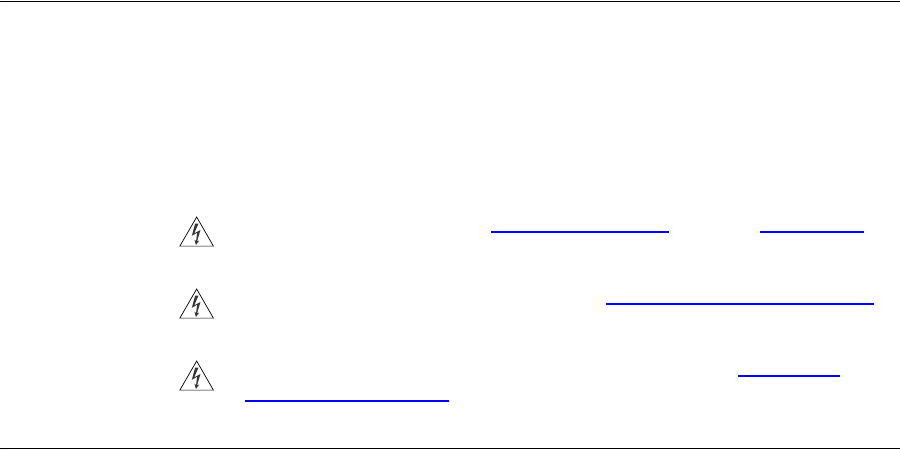
2HARDWARE INSTALLATION
Introduction This chapter will guide you through a basic installation of the Access Point,
including:
■Connecting the Access Point to your network.
■Setting up your computers for networking with the Access Point.
Safety Information
WARNING: Please read the “Safety Information” section in Appendix D
before you start.
VORSICHT: Bitte lesen Sie den Abschnitt “Wichtige Sicherheitshinweise”
sorgfältig durch, bevor Sie das Gerät einschalten.
AVERTISSEMENT: Veuillez lire attentivement la section “Consignes
importantes de sécurité” avant de mettre en route.
Positioning the Access
Point You should place the Access Point in a location that:
■allows convenient connection to the computer or other ethernet device that
will be connected to the LAN port on the rear panel.
■allows easy viewing of the front panel LED indicator lights, and access to
the rear panel connectors, if necessary.
■is centrally located to the wireless computers that will connect to the
Access Point. A suitable location might be on top of a high shelf or similar
furniture to optimize wireless connections to computers in both horizontal
and vertical directions, allowing wider coverage.

18 CHAPTER 2: HARDWARE INSTALLATION
When positioning your Access Point, ensure:
■It is out of direct sunlight and away from sources of heat.
■Cabling is away from power lines, fluorescent lighting fixtures, and
sources of electrical noise such as radios, transmitters and broadband
amplifiers.
■Water or moisture cannot enter the case of the unit.
■Air flow around the unit and through the vents in the side of the case is not
restricted. 3Com recommends you provide a minimum of 25 mm (1 in.)
clearance.
Using the Rubber Feet Use the four self-adhesive rubber feet to prevent your Access Point from
moving around on your desk or when stacking with other flat top
OfficeConnect units. Only stick the feet to the marked areas at each corner of
the underside of your Access Point.
Wall Mounting There are two slots on the underside of the Access Point that can be used for
wall mounting.
When wall mounting the unit, ensure that it is within reach of the power outlet.
You will need two suitable screws to wall mount the unit. To do this:
1Ensure that the wall you use is smooth, flat, dry and sturdy and make two
screw holes which are 150 mm (5.9 in.) apart.
2Fix the screws into the wall, leaving their heads 3 mm (0.12 in.) clear of the
wall surface.
3Remove any connections to the unit and locate it over the screw heads. When
in line, gently push the unit on to the wall and move it downwards to secure.
CAUTION: Only wall mount single units, do not wall mount stacked units.
Powering Up the
Access Point To power up the Access Point:
1Plug the power adapter into the power adapter socket located on the back
panel of the Access Point.
2Plug the power adapter into a standard electrical wall socket.

Connecting the Access Point 19
Connecting the
Access Point The first step for installing your Access Point is to physically connect it to a
switch or hub. See Figure 4.
Figure 4 Connecting the Access Point
To use your Access Point to connect to the wireless LAN to the wired LAN:
1Insert one end of the supplied Ethernet (RJ-45 Category 5) cable into the LAN
port on the rear panel of the Access Point.
2Insert the other end of the cable into the RJ-45 port on switch or hub. Check
that the LAN status LED lights on the Access Point.
You have now completed the hardware installation of your Access Point. Next
you need to set up your computers so that they connect to the Access Point.
OfficeConnect
Wireless Access Point
Hub / Switch
Wirele
ss
users
OfficeConnect 11Mbps Wireless Access Point
3CRWE41196
LAN StatusWLAN
Alert
20 CHAPTER 2: HARDWARE INSTALLATION

3RUNNING THE SETUP WIZARD
Accessing the Wizard 3Com recommends that you perform the initial Access Point configuration
from a computer that is directly connected to the LAN port and not from a
wireless connection.
However, you may configure the Access Point from a wireless admin
computer but, note that you may lose contact with the Access Point if you
change the wireless configuration. To communicate with the Access Point,
your wireless NIC should be set as follows:
■Encryption — none
■Service Area Name/SSID — 3Com
The Access Point setup program is Web-based, which means that it is
accessed through your Web browser (Netscape Navigator, Internet Explorer or
Mozilla).
To use the Setup Wizard:
1Ensure that you have at least one computer connected to the Access Point.
Refer to Chapter 2 for details on how to do this.
2Insert the Access Point CD-ROM in the CD-ROM drive on your computer. A
menu will appear; select Discovery.
Discovery will find the Access Point even if it is unconfigured or
misconfigured.
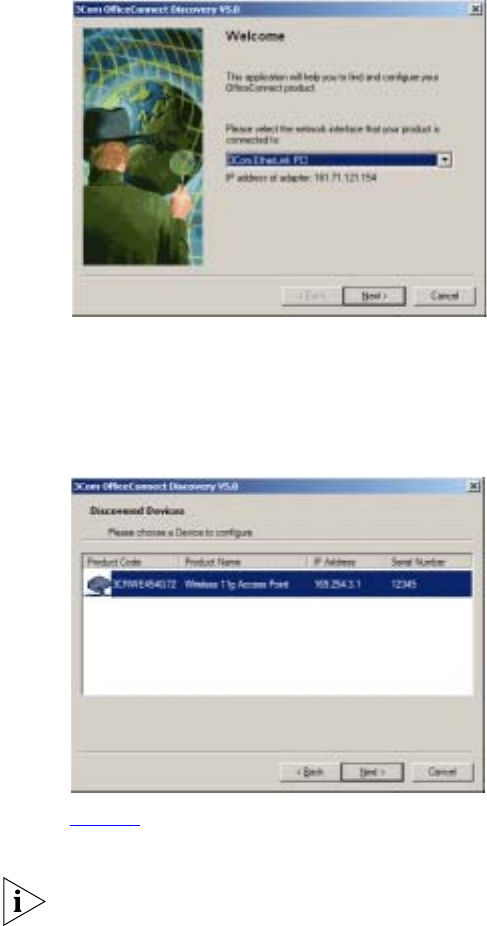
22 CHAPTER 3: RUNNING THE SETUP WIZARD
Figure 5 Discovery Welcome Screen
3When the Welcome screen is displayed, select the NIC from which the Access
Point will be discovered. Then click on Next and wait until the application
discovers the Access Points connected to your LAN.
Figure 6 Discovered Access Point Screen
4Figure 6 shows an example Discovered Devices screen. Highlight the Wireless
11a/b/g Access Point by clicking on it, and press Next.
If the discovery application finds multiple Access Points compare the serial
number on the Discovered Devices Screen with the serial number on the base
of your Access Point.

Accessing the Wizard 23
Figure 7 Discovery Finish Screen
5Click on Finish to launch a web browser and display the login page for the
Access Point as shown in Figure 8.
6To log in, enter the password (the default setting is admin) in the System
Password field and click Log in (Figure 8).
Figure 8 Access Point Login Screen

24 CHAPTER 3: RUNNING THE SETUP WIZARD
7If the password is correct, the Country & Mode Selection screen appears.
(Figure 9)
8Select the country in which the Access Point is to operate.
The Country Selection screen is only displayed on initial configuration of the
Access Point.
Figure 9 Country Selection Screen
9When you have logged in and selected a country either:
■The Status screen will appear (Figure 10). Select the Wizard option from
the menu on the left hand side.
or
■If your Access Point has not been configured before, the Wizard page will
be shown (refer to Figure 10).
10 Click Next.
11 You will be guided step by step through a basic setup procedure.
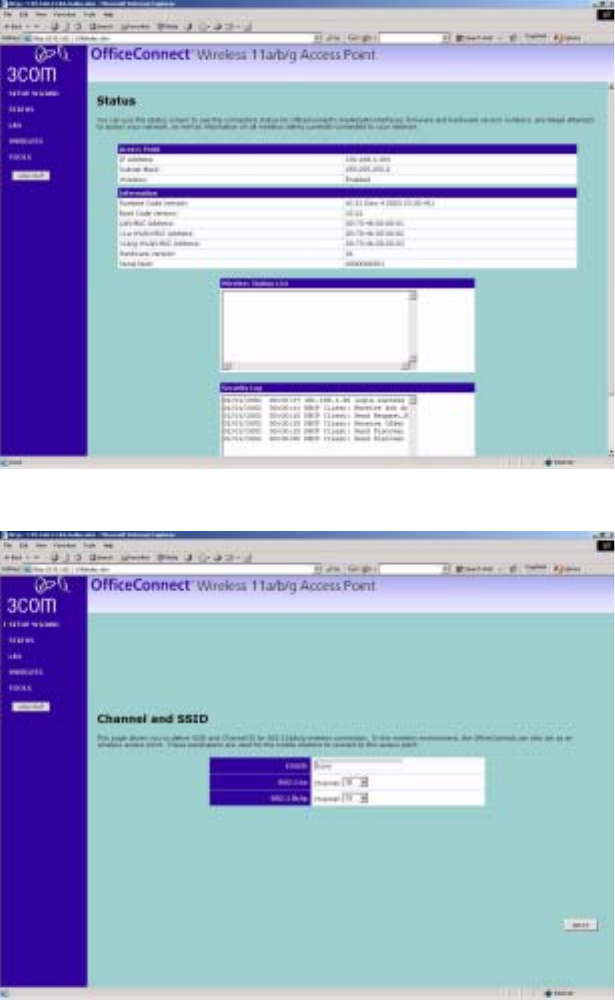
Accessing the Wizard 25
Figure 10 Welcome Screen
Figure 11 Setup Wizard
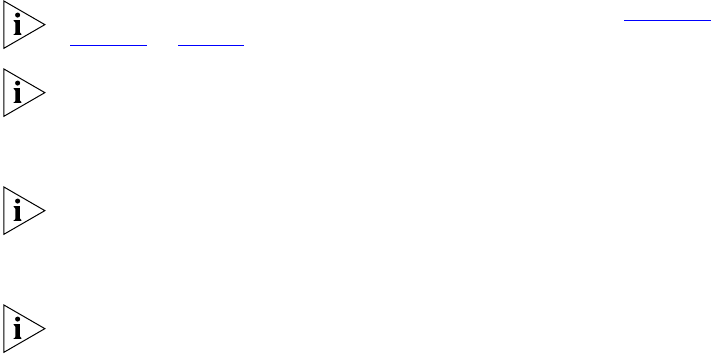
26 CHAPTER 3: RUNNING THE SETUP WIZARD
1Select channels for the Access Point to use or Auto if you want the Access
Point to choose an unused channel on start-up.
2Enter a Service Area Name/SSID.
The Service Area Name default for 3Com products is “3Com”. Up to 32 (case
sensitive) characters can be entered for the Service Area Name.
3Com strongly recommends that you change the SSID to something other than
the default.
For information on improving your Wireless network security see “Wireless
Settings” on page 39.
If you are configuring the Access Point from a wireless computer any changes
you make to the wireless configuration will result in communication between
the Access Point and your computer being lost. This is why 3Com strongly
recommends that you configure the Access Point from a wired computer.
It is very important that you set up your wireless clients to use the same
Service Area Name or SSID as the one you use on this screen. If your clients
use a different Service Area Name then they will not be able to communicate
with the Access Point.
The choice of channel is less important as Clients will generally search all of
the available channels. You should however make a note of the channel you
select as this may be useful if you experience problems with your clients.
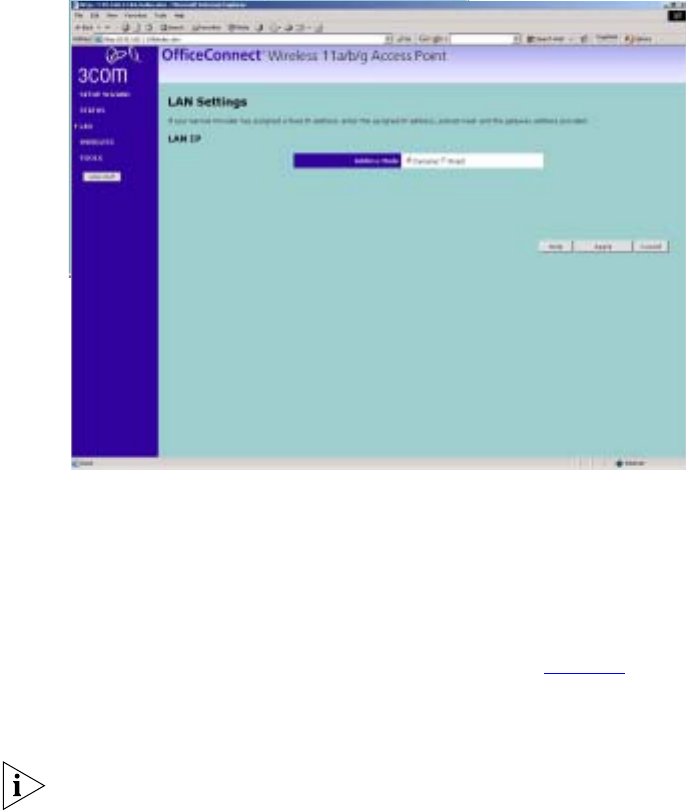
Accessing the Wizard 27
LAN Settings Figure 12 LAN Settings Screen
This screen determines how the Access Point obtains its IP address. There are
three options.
Obtain IP Address automatically - The Access Point will obtain an IP
address from a DHCP server already operating on your network.
Specify an IP address manually - Select this option to manually configure
the IP address of the Access Point. The screen shown in Figure 14 is
displayed. This screen displays a suggested LAN IP address, subnet mask and
default gateway of the Access Point. It also allows you to change the IP
address, subnet mask and default gateway.
3Com recommends that you manually assign your Access Point a static IP
address.
28 CHAPTER 3: RUNNING THE SETUP WIZARD

4ACCESS POINT CONFIGURATION
Navigating Through
the Access Point
Configuration Pages
This chapter describes all the screens available through the Access Point
configuration pages, and is provided as a reference. To get to the configuration
pages, browse to the Access Point by entering the URL in the location bar of
your browser. The URL is http://<IP Address of the Access
Point>, for example http://192.168.1.1. When you have browsed to
the Access Point, log in using your system password (default admin).
Main Menu At the left side of all screens is a main menu, as shown in Figure 18 on
page 32. When you click on a topic from the main menu, that page will appear
in the main part of the screen. If there are more option for the menu selection
then these will appear under the original menu option.
■Wizard - Allows a quick configuration of the basic functions of the Access
Point
■Status - displays the firmware version of the Access Point, current IP
address, lists showing connected wireless clients and log file entries.
■LAN - allows you to configure IP address, subnet mask, and default
gateway information.
■Wireless - enables /disables access from wireless computers, and provides
facilities for improving the security of the wireless network.
■Tools - allows the administrator to perform maintenance activities on the
Access Point.
Getting Help
On every screen, a Help button is available which provides access to the
context-sensitive online help system. Click Help for further assistance and
guidance relating to the current screen.
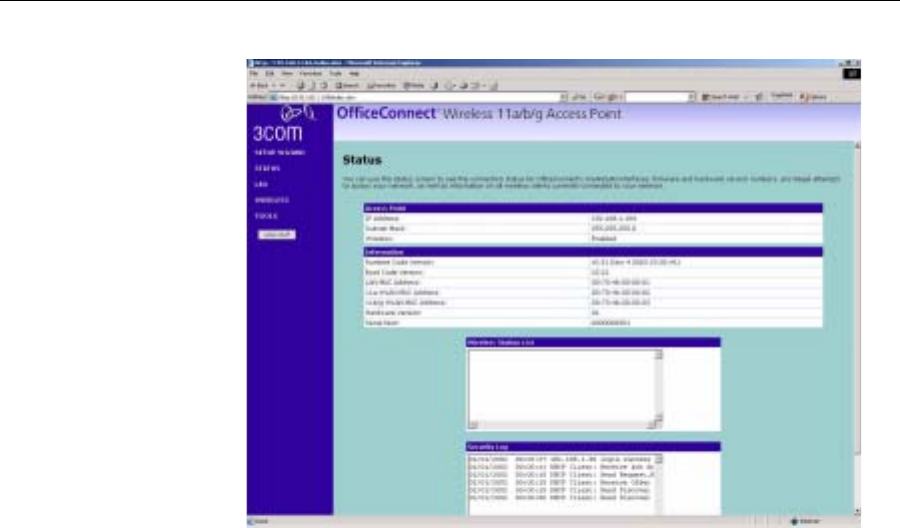
32 CHAPTER 4: ACCESS POINT CONFIGURATION
Status Page Figure 18 Access Point Status Screen
The Status section allows you to view the IP address of the unit, firmware
version, wireless clients and security log.
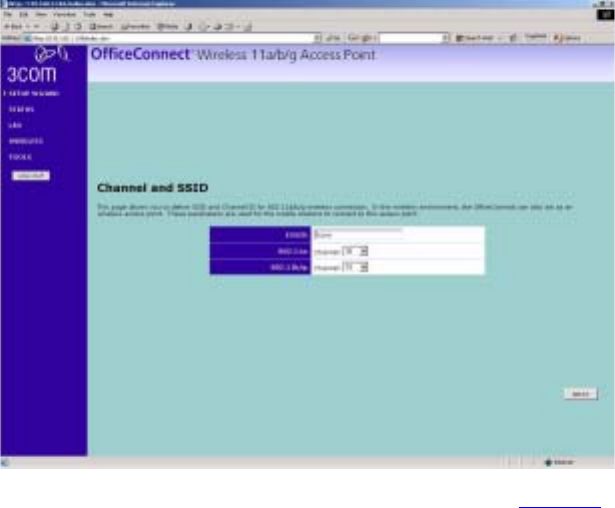
Status Page 33
Wizard Figure 19 Wizard Screen
Click WIZARD... to launch the configuration wizard. Refer to Chapter 3 for
information on how to run the wizard.
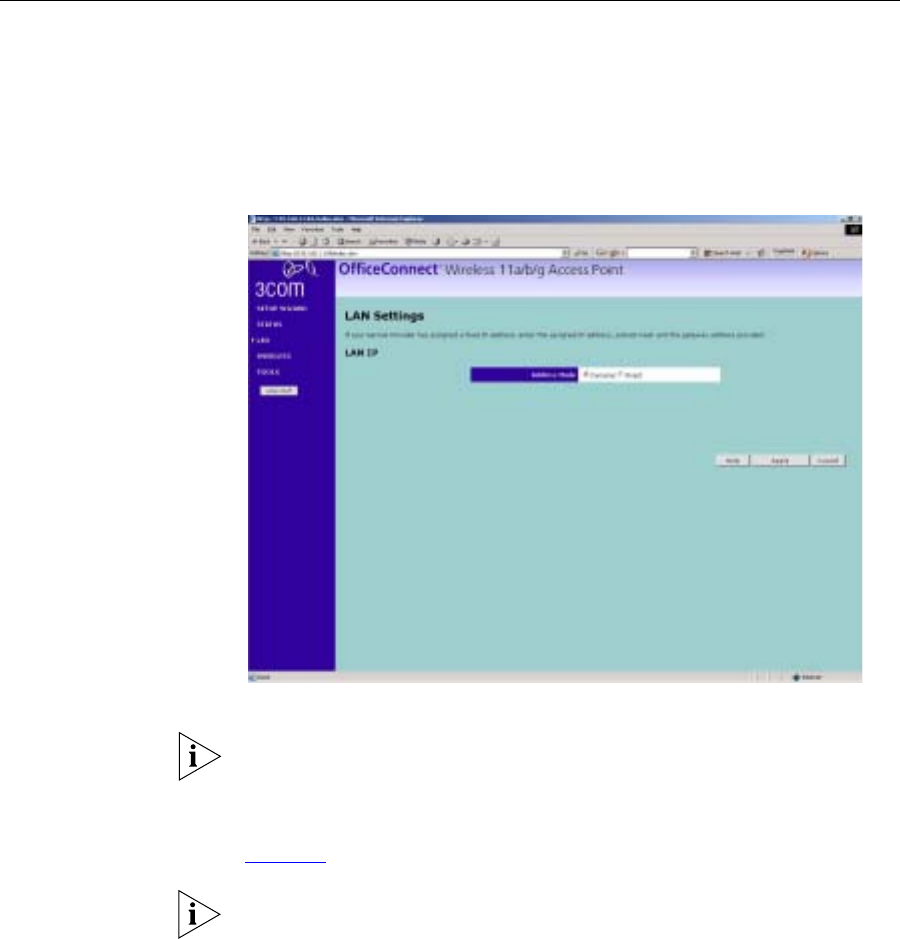
34 CHAPTER 4: ACCESS POINT CONFIGURATION
LAN Settings The LAN Settings menu provides the following options:
The LAN Settings screen is used to determine how the LAN IP address of
your Access Point is obtained. It can be obtained automatically or you can
manually configure the IP address.
Figure 20 Unit Configuration Screen
Dynamic IP Address
3Com recommends that you manually assign your Access Point a static IP
address.
Select Dynamic IP Address (automatically allocated) and the screen shown in
Figure 20 is displayed. Check all your settings and click Apply.
If the Access Point is set to obtain an IP address automatically and is unable
to contact a DHCP server then it will allocate itself an address in the
169.254.xxx.xxx range.
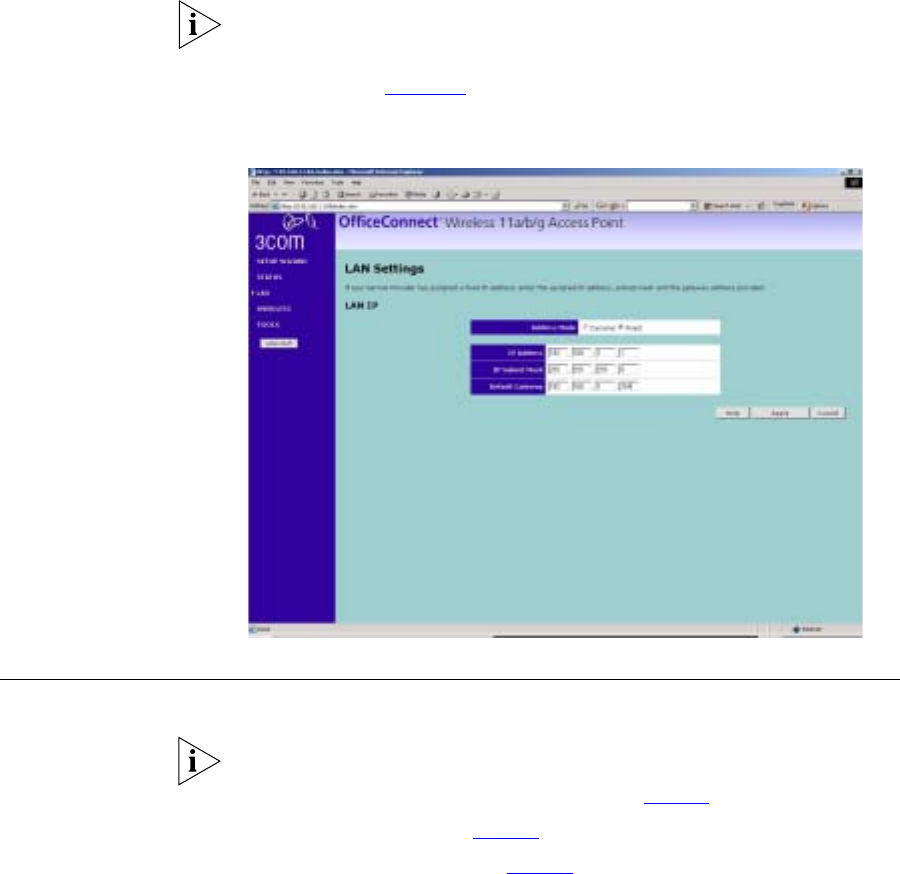
Wireless Settings 35
Manually setting the IP address
3Com recommends that you assign your Access Point a static IP address.
1Select LAN and then select Static IP Address (to be specified manually). The
screen shown in Figure 21 is displayed.
Figure 21 Unit Configuration Screen For Static IP Address
Wireless Settings
To improve the security of your wireless network, 3Com recommends that you:
1. Change the SSID from its default value - see page 37
2. Enable Encryption - see page 38
3. Enable Access Control - see page 42

36 CHAPTER 4: ACCESS POINT CONFIGURATION
Wireless Figure 22 Wireless Settings
Enable Wireless Networking
Allows you to enable/disable the wireless section of your LAN. When
disabled, no wireless PCs can gain access to your Wired or Wireless LAN
through this Access Point.

Wireless Settings 37
Channel Selection
The Channel Selectors allow you to specify which channels the Access Point
will transmit and receive on. If another Access Point nearby is using the same
channels as you, there will be a reduction in the performance of your network.
If this seems to be the case, you should select a different channel number.
Usually the Wireless computers will scan to find the correct channel, but if
they don't you must configure them to use the same channel number as the
Access Point.
Valid channels are country dependent. See “Channels” on page 97 for a list of
channels approved by each country.
Auto allows the Access Point to automatically select an available channel
when first powered on.
Service Area Name/SSID
This allows you to name your Wireless network. The field will accept any
alphanumeric string and has a maximum length of 32 characters. Your
Wireless computers must be configured with exactly the same name or you
will not be able to establish a connection. The Service Area Name may also be

38 CHAPTER 4: ACCESS POINT CONFIGURATION
referred to as “ESSID” depending on your networking vendor. By default the
Access Point uses the name “3Com”. 3Com recommends that you change the
default name. The same SSID will be used for both 11a and 11g.
In order that your wireless computers can connect to the Access Point, you
must:
■Use Infrastructure Mode not Adhoc Mode.
■Have the same Service Area Name as the Access Point.
■Use the same encryption type and keys as the Access Point.
■Ensure that the PC is included in the authorized Wireless PCs list if
Connection Control is enabled. See page 42.
Disable Broadcast SSID
This feature can be used to improve the security of your wireless network.
When the tickbox is checked, the Access Point will not broadcast the Service
Area Name/SSID of your wireless network. This will prevent unauthorized
clients from detecting your SSID and attempting to connect to your network.
If you have a wireless client that can detect all the available SSIDs in your
area, your client will not list the Access Point SSID when this feature is
enabled.
3Com recommends that you install your wireless network with this feature
disabled and then enable it once you have set up the Access Point and wireless
clients.
If you set the Access Point to Disable Broadcast SSID, the Access Point will
not allow access to clients with the SSID field set to “any”.
Encryption When setting up wireless networks, it is important to remember that with
encryption disabled, anyone with a Wireless PC can eavesdrop on your
network. 3Com recommends that you get the network working with
encryption disabled first and then enable it as the last step. This will simplify
setting up your network.
The Access Point supports two types of encryption:
■WPA — Wi-FI Protected Access (WPA) is a 256 bit encryption method
with keys that change over time.
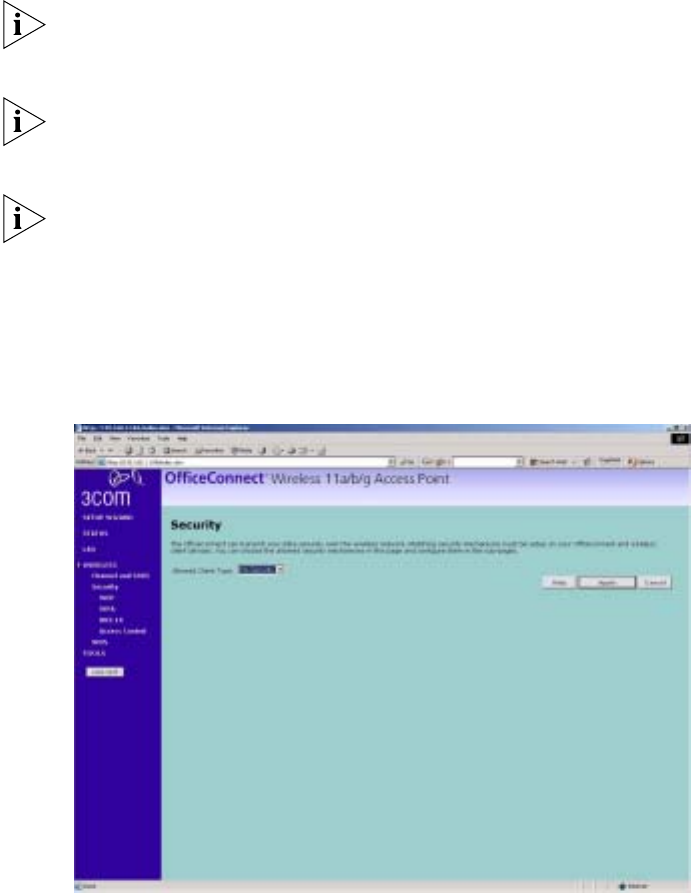
Wireless Settings 39
■WEP — Wireless Equivalent Privacy (WEP) is a 64 bit or 128 bit
encryption method with user configurable fixed keys.
WPA provides a higher level of security, provided by its longer key and
dynamic changes made to the key over time. 3Com recommends that you use
WPA with any clients which support it.
If you enable encryption on the Access Point, you must reconfigure your
wireless PCs to use exactly the same Encryption Type and Keys otherwise the
devices will not understand each other.
The encryption methods used by the Access Point secure data transmitted
through wireless communications between the Access Point and its wireless
clients. Enabling encryption has no security effect on data transmitted
through wired (Ethernet) connections or through your connections to the
Internet.
Configuring Encryption
Select from the drop down list WEP only, WPA only, WEP/WPA, or No
security.
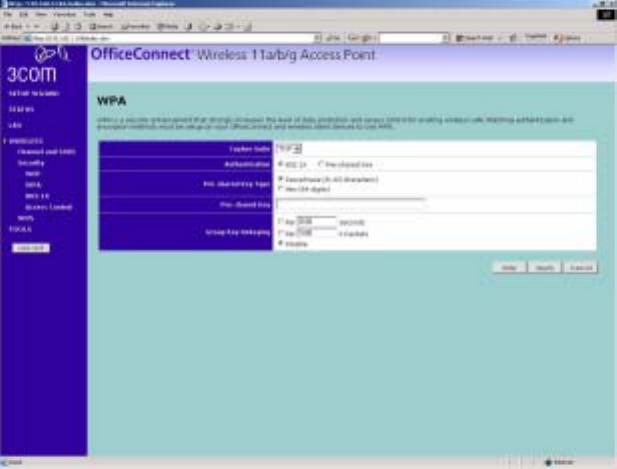
40 CHAPTER 4: ACCESS POINT CONFIGURATION
Configuring WPA
Encryption The only configuration that is needed for WPA is to enter the pre-shared key.
This key is used to start the dialog between the Access Point and the client.
During this dialog, a new key is agreed, making it more difficult to eavesdrop
on wireless networks encrypted using WPA, than those encrypted using WEP.
The pre-shared key can be entered as a 256 bit series of hexadecimal digits or
as a pass-phrase.
Figure 23 Encryption Keys Screen showing WPA configuration
To enter the pre-shared key as passphrase:
1Select Pre-shared Key from the Authentication options.
2Select Preshared key type passphrase.
3Enter a phrase of between 8 and 63 characters in length in the Pre-shared key
field. This passphrase will be used to generate a 256 bit key.
4Click Apply to generate the key.
To enter the pre-shared key as hexadecimal digits
1Select Pre-shared Key from the Authentication options.
2Select Preshared key type HEX.
3Enter 64 HEX digits in the pre-shaed key field
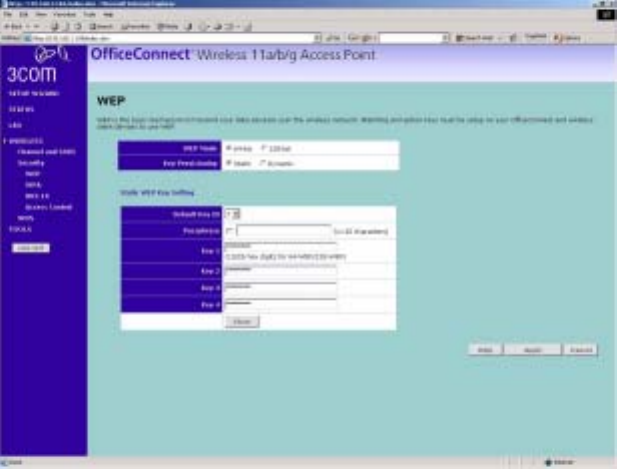
Wireless Settings 41
4Click Apply to generate the key.
If 802.1X authentication is to be used please see page ??.
Configuring WEP
Encryption There are two levels of WEP encryption available, 64 bit (sometimes referred
to as 40 bit) and 128 bit. 128 bit will result in a higher level of security, but
may cause a slight decrease in performance.
Encryption Keys
Figure 24 Encryption Keys Screen showing WEP configuration
A Key is a hexadecimal (0-9, A-F) number used to encrypt and decrypt the
data. There can be up to 4 keys and each key can be as long as 26 digits. The
Access Point also offers a method for converting plain text into hex keys. The
text is much easier to remember than hex keys but it relies on your wireless
adapters also supporting this feature. Different manufacturers have developed
different ways of converting plain text and so interoperability is not
guaranteed. If you are experiencing difficulty, the Manual Hex Key method is
supported by most vendors.
There are two methods available to generate the encryption keys:

42 CHAPTER 4: ACCESS POINT CONFIGURATION
■Manual Key Entry - This method allows you to manually enter hex keys.
Virtually all manufacturers support this scheme. Hexadecimal numbers are
formed from 0-9 and A-F. Enter 10 or 26 digits depending on whether you
are using 64 0r 128 bit WEP respectively.
■Passphrase - This is another common method. In 64 bit WEP, the
passphrase will generate 4 different keys. However, in 128 bit WEP, this
method only generates 1 key which is replicated for all 4 keys. The
passphrase can be up to 31 characters long and may contain any
alphanumeric characters.
If passphrase encryption is to used then tick the passphrase box. If Manual
HEX is to be used leave this box unticked.
If you encounter any difficulty when you enable WEP ensure that you check
that each key on your wireless computer is exactly the same as each key on
your Access Point. In other words, Key number 1 on the Wireless computer
must have the same Hex number as Key number 1 on the Access Point, Key 2
on the Wireless computer must match Key 2 on the Access Point and so on.
The Active Transmit Key selects which of the 4 Keys the Access Point uses
when it transmits. You can change the selected key periodically to increase the
security of your network.
Some wireless adapters have only one key available on their WEP
configuration page. If this is the case ensure it is the same as Key 1 on the
Access Point and that it is selected as the active transmit key.
Access Control This screen allows you to determine if all Wireless PCs or just authorised
Wireless PCs can use the Access Point. Select Access Control to display the
screen shown in Figure 25.
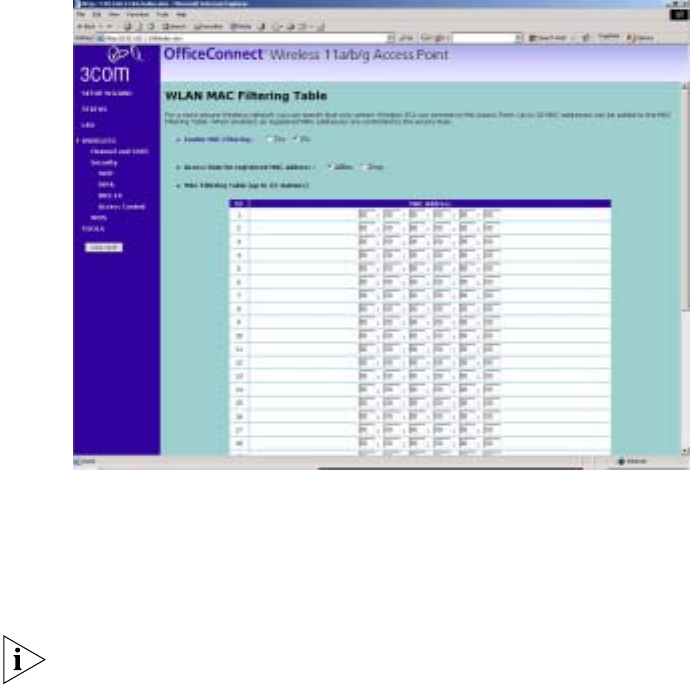
Wireless Settings 43
Figure 25 Connection Control Screen
A higher level of security can be achieved for your wireless network if you
use both encryption and you specify only certain wireless computers can
connect to the Access Point. By default, any wireless computer that has the
same Service Area Name/SSID, channel and encryption settings as the Access
Point can connect to it.
If you enable this feature from a Wireless PC, it will automatically be added to
the Authorised Wireless PC list.
Authorised Wireless PCs
To create a list of Wireless computers that can access the Access Point:
1Select Yes to enable MAC filtering.
2Select Allow for the Access Rule.
3Enter upto 32 MAC addresses that you want to allow access to the network.
This list can also be used as a deny list. If this is the required function select
Deny as the Access Rule.
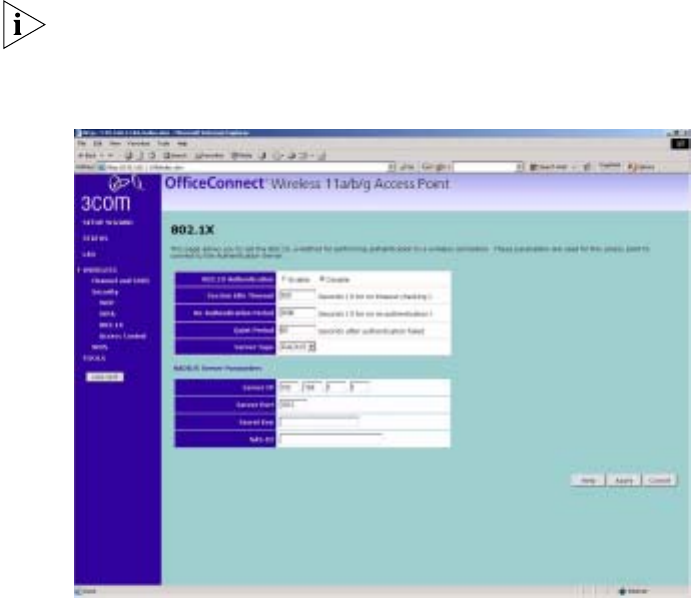
44 CHAPTER 4: ACCESS POINT CONFIGURATION
Deleting a MAC Address
The connection rights for a Wireless PC listed in the table can be removed by
deleting that entry in the table.
Once an entry has been deleted it cannot be undone. Please wait 30 seconds
for changes to take effect.
802.1X Authentication
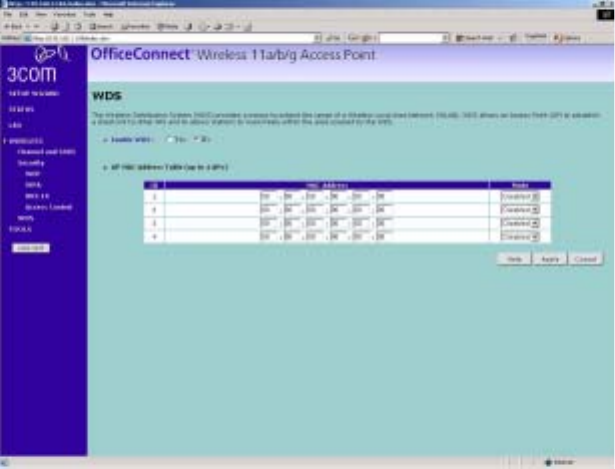
Wireless Settings 45
WDS (Wireless
Distributed System)
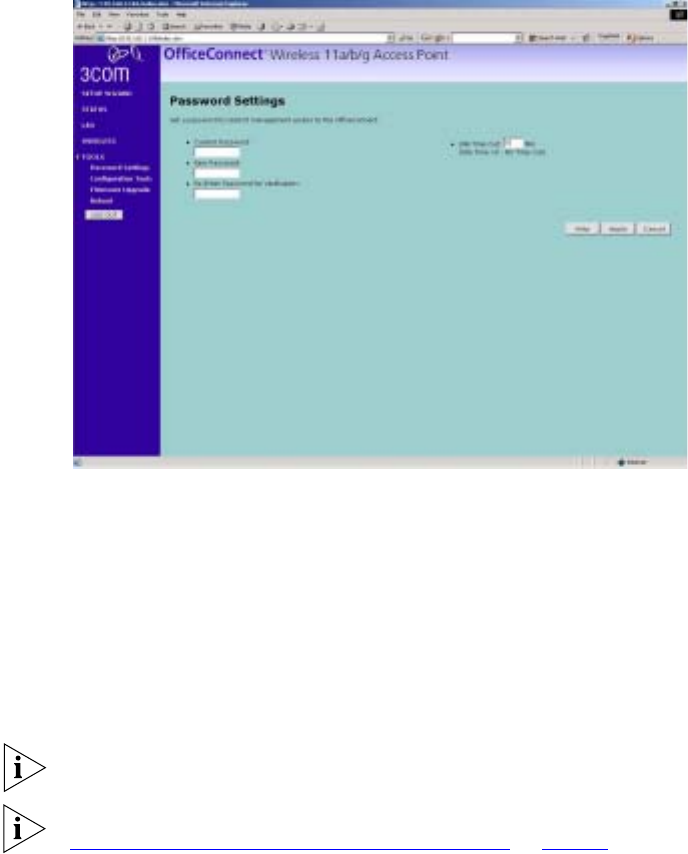
46 CHAPTER 4: ACCESS POINT CONFIGURATION
Password Figure 26 Password Screen
Changing the Administration Password
You can change the password to prevent unauthorized access to the
Administration System. To do this:
1Enter the current password in the Current Password field
2Enter the new password in the New Password field
3Enter the new password again in the Re-Enter Password field
4Click Apply to save the new password
The password is case sensitive.
If you have forgotten your password you need to reset the Access Point. See
“Forgotten Password and Reset to Factory Defaults” on page 66
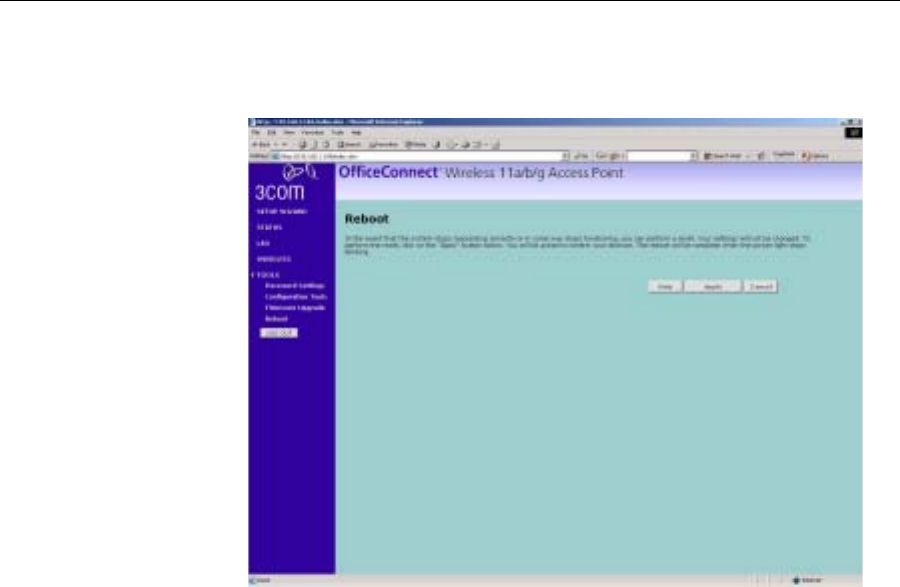
System Tools 47
System Tools
Reboot Figure 27 Reboot Screen
If your Access Point is not operating correctly, you can choose to restart the
Access Point by selecting Reboot the Access Point and then clicking Apply,
simulating the effect of power cycling the unit. No configuration information
will be lost but the log files will be erased. Any network users who are
currently connected to the Access Point will have their access interrupted
whilst the restart takes place, and they may need to reboot their computers
when the restart has completed and the Access Point is operational again.
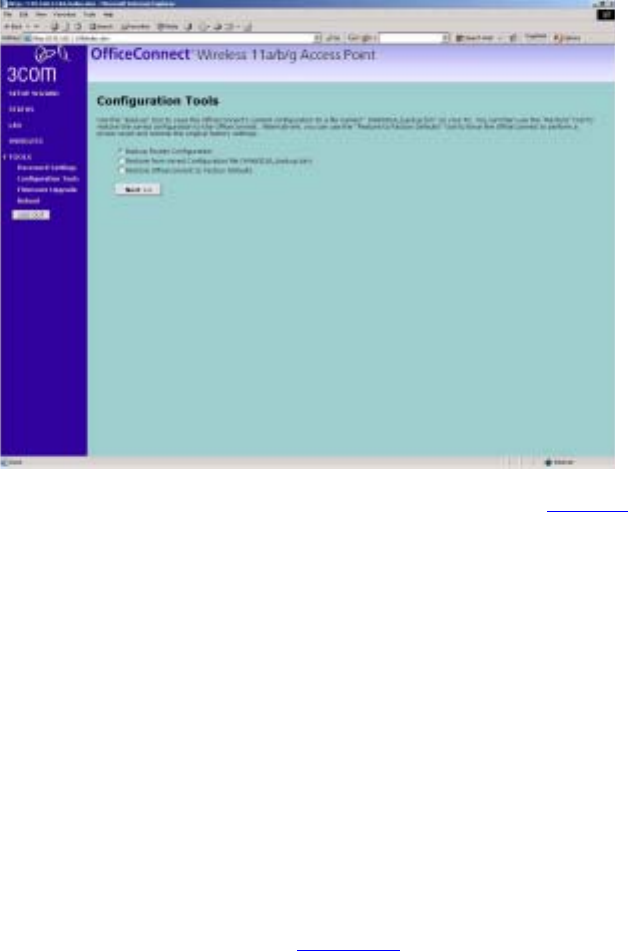
48 CHAPTER 4: ACCESS POINT CONFIGURATION
Configuration Tools Figure 28 Configuration Tools Screen
Select the Configuration tab to display the Configuration screen (Figure 28).
Backup Configuration
Select BACKUP to save the current Access Point configuration. You will be
prompted to download and save a file to disk.
Restore Configuration Data
If you want to reinstate the configuration settings previously saved to a file,
Select Restore from Store Configuration File.
Reset to Factory Default
If you want to reset the settings on your Access Point to those that were loaded
at the factory, select Restore OfficeConnect to Factory Defaults. You will lose
all your configuration changes. The Access Point reverts to a DHCP client and
will therefore restart requiring a new IP address. To communicate with the
Access Point you may need to rerun the DISCOVERY software to find out the
IP address of the Access Point. See Appendix A for more information. You
may need to reconfigure and restart your computer to re-establish
communication with the Access Point.
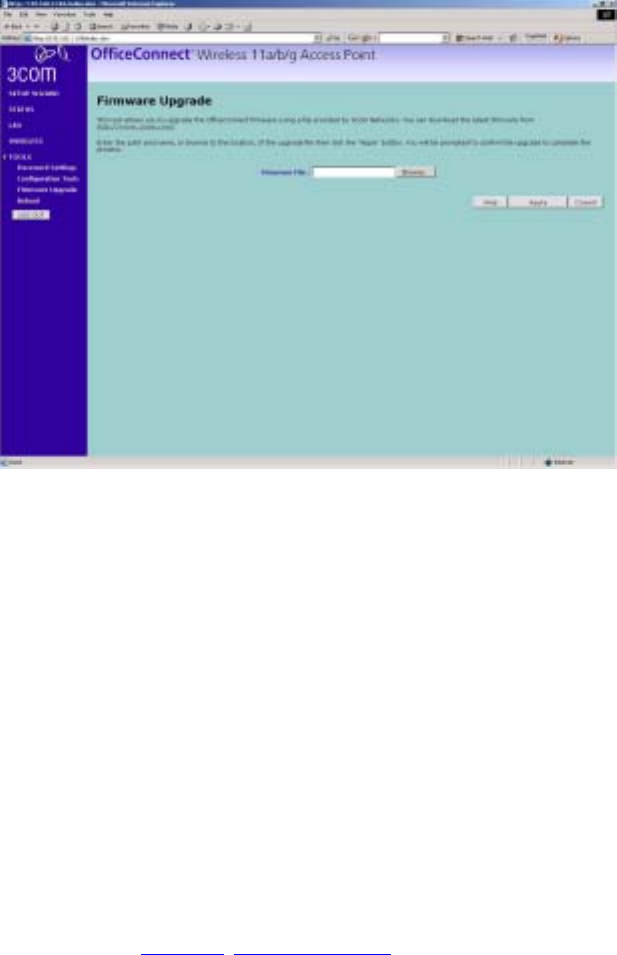
System Tools 49
Firmware Upgrade Figure 29 Firmware Upgrade Screen
The Upgrade facility allows you to install on the Access Point any new
releases of system software that 3Com may make available. To install new
software, you first need to download the software from the 3Com support web
site to a folder on your computer. Once you have done this, select Browse to
tell your web browser where this file is on your computer, and then click
Apply. The file will be copied to the Access Point, and once this has
completed, the Access Point will restart. Although the upgrade process has
been designed to preserve your configuration settings, it is recommended that
you make a backup of the configuration beforehand, in case the upgrade
process fails for any reason (for example, the connection between the
computer and the Access Point is lost while the new software is being copied
to the Access Point).
The upgrade procedure can take up to two minutes, and is complete when the
Alert LED has stopped flashing and is permanently off. Make sure that you do
not interrupt power to the Access Point during the upgrade procedure; if you
do, the software may be corrupted and the Access Point may not start up
properly afterwards. If the Alert LED comes on continuously after a failed
upgrade, refer to Chapter 6,“Troubleshooting”.
50 CHAPTER 4: ACCESS POINT CONFIGURATION

6TROUBLESHOOTING
Basic Connection
Checks
■Check that the Access Point is connected to your switch or hub and that all
the equipment is powered on. Check that the LAN port link status LED on
the Access Point are illuminated, and that any corresponding LEDs are
also illuminated.
■Ensure that the computers have completed their start-up procedure and are
ready for use. Some network interfaces may not be correctly initialised
until the start-up procedure has completed.
■If the link status LED does not illuminate for the LAN port, check that you
do not have a faulty cable. Try a different cable. Check also that the
Uplink/Normal switch on the hub or switch is in the correct position.
Browsing to the
Access Point
Configuration
Screens
If you have connected your Access Point, admin computer and switch
together but cannot browse to the Access Point configuration screens, check
the following:
■Confirm that the physical connection between your computer and the
Access Point is OK, and that the link status LEDs on the Access Point and
NIC are illuminated and indicating the same speed (10Mbps or 100Mbps).
Some NICs do not have status LEDs, in which case a diagnostic program
may be available that can give you this information.
■Ensure that your computer is configured correctly. Make sure that the
computer can communicate with other devices on the network. Ensure that
the NIC is configured for autonegotiation.
■Ensure that you do not have a Web proxy enabled on your computer. Go to
the Control Panel and click on Internet Options. Select the Connections
tab and click on the LAN Settings button at the bottom. Make sure that the
Use Proxy Server option is unchecked.

66 CHAPTER 6: TROUBLESHOOTING
■When entering the address of the Access Point into your web browser,
ensure that you use the full URL including the http:// prefix (e.g.
http://192.168.1.1).
■If you cannot browse to the Access Point, re-run the DISCOVERY
software described in Appendix A to discover the Access Point and the IP
address it has been allocated from the DHCP server. If there is no DHCP
server on your network, the DISCOVERY software changes the IP address
of the Access Point so that it is in the same subnet as your admin computer.
Forgotten Password
and Reset to Factory
Defaults
If you can browse to the Access Point configuration screen but cannot log on
because you do not know or have forgotten the password, follow the steps
below to reset the Access Point to it’s factory default configuration.
CAUTION: All your configuration changes will be lost, and you will need to
run the configuration wizard again before you can re-establish your wireless
network. All other computer users will lose their network connections whilst
this process is taking place, so choose a time when this would be convenient.
1Remove power from the Access Point.
2Hold down the Reset button on the rear of the unit and re-apply power to the
Access Point. The Alert LED will flash as the Access Point starts up, and after
approximately 30 seconds will start to flash more slowly (typically 2 seconds
on, 2 seconds off). Once the Alert LED has started to flash slowly. Keep Reset
button held down and remove power from the Access Point.
3Release the Reset button.
4Re-apply power to the Access Point, and when the start-up sequence has
completed, browse to the IP address of the Access Point and run the
configuration wizard. You may need to restart your computer before you
attempt this.
5When the configuration wizard has completed, you may reconnect your
network as it was before.
Wireless Networking ■Ensure that you have a Wi-Fi certified 802.11a, 802.11b, or 802.11g
wireless adapter for each wireless computer, and that it is correctly
installed and configured. Verify that each Wireless computer has either
Windows 95 or higher or MAC OS 8.5 or higher.
■Verify that your wireless computers are configured to work in
Infrastructure mode and not Ad Hoc mode. The Access Point is designed

Wireless Networking 67
to operate in Infrastructure mode. Ad Hoc mode is not supported by the
Access Point.
■If you have a wired and wireless NIC in the same computer, ensure that the
wired NIC is disabled.
■Check the status of the Access Point Wireless LED, it should be lit if
wireless is enabled and will flash when there is wireless activity. If not lit
go to “Wireless Settings” on page 35 and enable wireless networking.
■Ensure that the TCP/IP settings for all devices are correct.
■Ensure that the Wireless Clients are using the same SSID or Service Area
Name as the Access Point. The SSID is case-sensitive
■Ensure that you are using the same level of security on all of your wireless
computers (None, 40/64 or 128 bit) and that all devices are using the same
keys, and the same order of keys where appropriate.
■Ensure that you have the Wireless computer enabled in the list of allowed
MAC addresses if you are using Wireless Connection control on the
Access Point.
■If you are having difficulty connecting or are operating at a low speed try
changing the antenna positions on the rear of the Access Point. For more
effective coverage you can try reorientating your antennae. Place one
antenna vertically and one horizontally to improve coverage. Additionally
consider moving the wireless computer closer to the Access Point to
confirm that the building structure or fittings are not adversely affecting
the connectivity. If this resolves the problem consider relocating the
Wireless computer or select Clear Channel Select on the Access Point.
■Sources of interference: The 2.4Ghz ISM band is used for 802.11b. This is
generally a licence free band for low power applications, and you may
have other devices at your location that operate in this frequency band.
You should take care to ensure that there are no devices like microwave
ovens for example close to the Access Point or wireless computers as this
could affect receiver sensitivity and reduce the performance of your
network. If you are unsure try relocating both the wireless computers and
the Access Point to establish whether this problem exists.
■Most wireless computer Adapters will scan the channels for the wireless
Access Point. If a wireless computer has not located the Access Point then
try initiating a search manually if the client software supports this feature
or manually set the channel on your wireless computer to correspond to the
Access Point channel number. Please refer to your Wireless computer
adapter documentation and vendor to do this.

68 CHAPTER 6: TROUBLESHOOTING
■Speed of connection: The 802.11a/b/g standards will automatically choose
the best speed depending on the quality of your connection. As the signal
quality weakens then the speed falls back to a lower speed. In general the
closer you are to the Access Point the better the speed. If you are not
achieving the speed you had anticipated then try moving the antenna on
the Access Point or moving the Wireless computer closer to the Access
Point. In an ideal network the Access Point should be located in the centre
of the network with Wireless computers distributed around it. Applications
are generally available with the computer wireless card to carry out a site
survey. Use this application to find the optimal siting for your wireless
computer. Consult your Wireless Card documentation and vendor for more
details.
Alert LED The Alert LED will flash when the Access Point unit is first powered up while
the system software checks the hardware for proper operation. Once the
Access Point has started normal operation, the Alert LED will go out.
■If the Alert LED does not go out following start up, but illuminates
continuously, this indicates that the software has detected a possible fault
with the hardware. Remove power from the Access Point, wait 10 seconds
and then re-apply power. If the Alert LED comes on continuously again,
then a fault has been detected. Locate the copy of the Access Point
software on the 3Com web site (http://www.3com.com) and upload it to
the Access Point to see if this clears the fault (refer to “Recovering from
Corrupted Software” below). If this does not fix the problem, contact your
supplier for further advice.
Recovering from
Corrupted Software If the Alert LED remains permanently on following power-up, it is possible
that the system software has become corrupted. In this condition, the Access
Point will enter a “recovery” state. Follow the instructions below to upload a
new copy of the system software to a Access Point unit in this state.
Ensure that one of your computers has a copy of the new software image file
stored on its hard disk or available on CD-ROM.
The latest software is available on 3Com’s Web site at:
www.3com.com.

Frequently Asked Questions 69
1Remove power from the Access Point and connect the admin computer to the
LAN port.
2Run the Discovery application included on the product CD.
3This will connect you to the Microcode Recovery utility in the Access Point.
4Follow the on-screen instructions. Enter the path and filename of the software
image file.
5When the upload has completed, the Access Point will restart, run the self-test
and, if successful, resume normal operation. The Alert LED will go out.
6Reconnect your Access Point to your network.
If the Access Point does not resume normal operation following the upload, it
may be faulty. Contact your supplier for advice.
Frequently Asked
Questions How do I reset the Access Point to Factory Defaults?
See “Forgotten Password and Reset to Factory Defaults” on page 66.
How many wireless clients does the Access Point support?
A maximum of 128 wireless clients are supported.
There is a single LAN ports on the Access Point. How are additional
computers connected?
You can expand the number of connections available on your LAN by
using hubs, switches and wireless access points connected to the
Access Point. 3Com wireless access points and OfficeConnect hubs
and switches provide a simple, reliable means of expanding your
network; contact your supplier for more information, or visit:
http://www.3com.com/
Where can I download software upgrades for the Access Point?
Upgrades to the Access Point software are posted on the 3Com support
web site, accessible by visiting:
http://www.3com.com.
What other online resources are there?
The 3Com Knowledgebase at:
70 CHAPTER 6: TROUBLESHOOTING
http://knowledgebase.3com.com
is a database of technical information covering all 3Com products. It is
updated daily with information from 3Com technical support services,
and it is available 24 hours a day, 7 days a week.
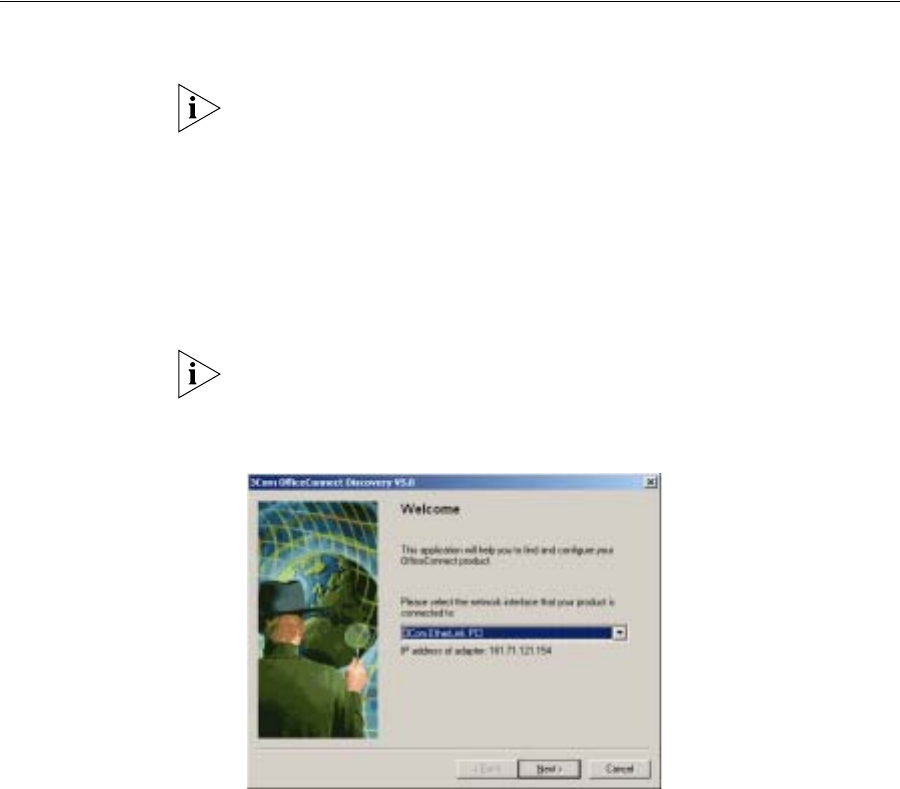
AUSING DISCOVERY
Running the
Discovery
Application
3Com provides a user friendly Discovery application for detecting the Access
Point on the network.
If you are unable to use the Discovery application, the Access Point on initial
power-up will attempt to obtain an IP address from your local DHCP server.
Consult your DHCP Server log to obtain the IP address that was allocated to
your Access Point.
Windows Installation
(95/98/2000/Me/NT/XP)
1Insert the Access Point CD-ROM in the CD-ROM drive on your computer. A
menu will appear; select Discovery.
Discovery will find the Access Point even if it is unconfigured or
misconfigured.
Figure 44 Discovery Welcome Screen

72 APPENDIX A: USING DISCOVERY
2When the Welcome screen is displayed, select the NIC from which the Access
Point will be discovered. Then click on Next and wait until the application
discovers the Access Points connected to your LAN.
Figure 45 Discovered Access Point Screen
3Figure 45 shows an example Discovered Devices screen. Highlight the
Wireless 11g Access Point by clicking on it, and press Next.
Figure 46 Discovery Finish Screen
4Click on Finish to launch a web browser and display the login page for the
Access Point.

BIP ADDRESSING
The Internet Protocol
Suite The Internet protocol suite consists of a well-defined set of communications
protocols and several standard application protocols. Transmission Control
Protocol/Internet Protocol (TCP/IP) is probably the most widely known and is
a combination of two of the protocols (IP and TCP) working together. TCP/IP
is an internationally adopted and supported networking standard that provides
connectivity between equipment from many vendors over a wide variety of
networking technologies.
Managing the Access
Point over the
Network
To manage a device over the network, the Access Point must be correctly
configured with the following IP information:
■An IP address
■A Subnet Mask
■Default Gateway
IP Addresses and
Subnet Masks Each device on your network must have a unique IP address to operate
correctly. An IP address identifies the address of the device to which data is
being sent and the address of the destination network. IP addresses have the
format n.n.n.x where n is a decimal number between 0 and 255 and x is a
number between 1 and 254 inclusive.
However, an IP Address alone is not enough to make your device operate. In
addition to the IP address, you need to set a subnet mask. All networks are
divided into smaller sub-networks and a subnet mask is a number that enables
a device to identify the sub-network to which it is connected.

74 APPENDIX B: IP ADDRESSING
For your network to work correctly, all devices on the network must have:
■The same sub-network address.
■The same subnet mask.
The only value that will be different is the specific host device number. This
value must always be unique.
An example IP address is ‘192.168.100.8’. However, the size of the network
determines the structure of this IP Address. In using the Access Point, you will
probably only encounter two types of IP Address and subnet mask structures.
Type One
In a small network, the IP address of ‘192.168.100.8’ is split into two parts:
■Part one (‘192.168.100’) identifies the network on which the device
resides.
■Part two (‘.8’) identifies the device within the network.
This type of IP Address operates on a subnet mask of ‘255.255.255.0’.
See Table 3 for an example about how a network with three computers and a
Access Point might be configured.
Table 3 IP Addressing and Subnet Masking
Type Two
In larger networks, where there are more devices, the IP address of
‘192.168.100.8’ is, again, split into two parts but is structured differently:
■Part one (‘192.168’) identifies the network on which the device resides.
■Part two (‘.100.8’) identifies the device within the network.
This type of IP Address operates on a subnet mask of ‘255.255.0.0’.
Device IP Address Subnet Mask
PC 1 192.168.100.8 255.255.255.0
PC 2 192.168.100.33 255.255.255.0
PC 3 192.168.100.188 255.255.255.0
Access Point 192.168.100.72 255.255.255.0

How does a Device Obtain an IP Address and Subnet Mask? 75
See Table 4 for an example about how a network (only four computers
represented) and a Access Point might be configured.
Table 4 IP Addressing and Subnet Masking
How does a Device
Obtain an IP Address
and Subnet Mask?
There are three different ways to obtain an IP address and the subnet mask.
These are:
■Dynamic Host Configuration Protocol (DHCP) Addressing
■Static Addressing
■Automatic Addressing (Auto-IP Addressing)
DHCP Addressing The Acces Point can obtain an address from a DHCP server on the current
network..
Static Addressing You must enter an IP Address and the subnet mask manually on every device.
Using a static IP and subnet mask means the address is permanently fixed.
Auto-IP Addressing Network devices use automatic IP addressing if they are configured to acquire
an address using DHCP but are unable to contact a DHCP server. Automatic
IP addressing is a scheme where devices allocate themselves an IP address at
random from the industry standard subnet of 169.254.x.x (with a subnet mask
of 255.255.0.0). If two devices allocate themselves the same address, the
conflict is detected and one of the devices allocates itself a new address.
Automatic IP addressing support was introduced by Microsoft in the
Windows 98 operating system and is also supported in Windows 2000.
Device IP Address Subnet Mask
PC 1 192.168.100.8 255.255.0.0
PC 2 192.168.201.30 255.255.0.0
PC 3 192.168.113.155 255.255.0.0
PC 4 192.168.002.230 255.255.0.0
Access Point 192.168.002.72 255.255.0.0
76 APPENDIX B: IP ADDRESSING

CTECHNICAL SPECIFICATIONS
This section lists the technical specifications for the OfficeConnect Wireless
11g Access Point.
Wireless 11g Access
Point Interfaces
LAN connection - 10Mbps/100Mbps dual speed Ethernet port
(10BASE-T/100BASE-TX)
WLAN Interfaces
Standard IEEE 802.11a, Orthogonal Frequency Division Multiplexing
(OFDM)
Transmission rate: 54Mbps, automatic fallback to 48, 36, 24, 18, 12, or
6Mbps
Maximum channels: 20
Range up to 304.8m (1000ft)
Frequency: (US/Canada/Europe) 5.150-5.825 GHz
Sensitivity: 6, 12, 18, 24, 36, 48 Mbps: -85 dBm;
54 Mbps -66 dBm typical
Modulation: BPSK OFDM, QPSK OFDM
Encryption: 40/64 bit WEP, 128 bit WEP, WPA
Maximum clients: 128
O/P Power: 18dBm
Standard IEEE 802.11g, Direct Sequence Spread Spectrum (DSSS)
Transmission rate: 54Mbps, automatic fallback to 48, 36, 24, 18, 12, or
6Mbps
Maximum channels: 14
Range up to 304.8m (1000ft)
Frequency: (US/Canada/Europe) 2.400-2.4835 GHz
Sensitivity: 6, 12, 18, 24, 36, 48 Mbps: -85 dBm;
78 APPENDIX C: TECHNICAL SPECIFICATIONS
54 Mbps -66 dBm typical
Modulation: CCK, BPSK, QPSK, OFDM
Encryption: 40/64 bit WEP, 128 bit WEP, WPA
Maximum clients: 128
O/P Power: 18dBm
Standard IEEE 802.11b, Direct Sequence Spread Spectrum (DSSS)
Transmission rate: 11bps, automatic fallback to 5.5, 2, or 1 Mbps
Maximum channels: 14
Range up to 304.8m (1000ft)
Frequency: (US/Canada/Europe) 2.400-2.4835 GHz
Sensitivity: 1, 2, 5.5 Mbps: -85 dBm; 11 Mbps -82 dBm typical
Modulation: CCK, BPSK, QPSK, OFDM
Encryption: 40/64 bit WEP, 128 bit WEP, WPA
Maximum clients: 128
O/P Power 18dBm
Operating Temperature
0 °C to 40 °C (32 °F to 105 °F)
Power
7VA, 23.9 BThU/hr
Humidity
0 % to 90 % (non-condensing) humidity
Dimensions
■Width = 220 mm (8.7 in.)
■Depth = 135 mm (5.3 in.)
■Height = 24 mm (1 in.)
Weight
Approximately 500 g (1.1 lbs)
Standards Functional: ISO 8802/3
IEEE 802.3
IEEE 802.11b, 802.11g, 802.11a, Wi-Fi
Safety: UL60950
CSA 22.2 #60950
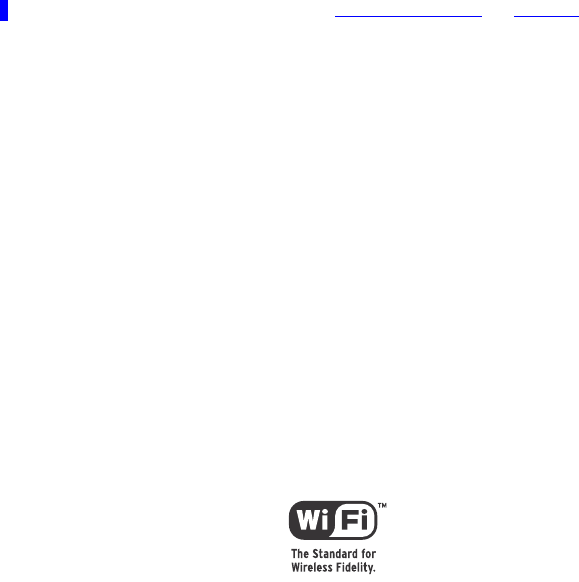
79
IEC 60950
EN 60950
EMC: EN 55022 Class B
EN 55024
CISPR 22
FCC Part 15 Class B*
ICES-003 Class B
CNS 13438 Class A
ETSI EN 301 489–17
Radio CFR 47 FCC Part 15.207, 15.209, 15.247 and 15.249.
ETS 300 328 (2.4 GHz ISM band wide band transmission
systems.
RSS-210
Environmental: EN 60068 (IEC 68)
*See “FCC Statement” on page 97 for conditions of operation.
System Requirements Operating Systems
The Access Point will support the following Operating Systems:
■Windows 95/98
■Windows NT 4.0
■Windows ME
■Windows 2000
■Windows XP
■Mac OS 8.5 or higher
■Unix
Ethernet Performance The Access Point complies to the IEEE 802.3i, u and x specifications.
Wireless Performance The Access Point has been designed to conform to the Wi-Fi interoperability
test standard.
80 APPENDIX C: TECHNICAL SPECIFICATIONS
Cable Specifications The Access Point supports the following cable types and maximum lengths:
■Category 3 (Ethernet) or Category 5 (Fast Ethernet or Dual Speed
Ethernet) Twisted Pair — shielded and unshielded cable types.
■Maximum cable length of 100m (327.86 ft).

DSAFETY INFORMATION
Important Safety
Information WARNING: Warnings contain directions that you must follow for your
personal safety. Follow all directions carefully.
You must read the following safety information carefully before you install
or remove the unit:
WARNING: The Access Point generates and uses radio frequency (rf) energy.
In some environments, the use of rf energy is not permitted. The user should
seek local advice on whether or not rf energy is permitted within the area of
intended use.
WARNING: Exceptional care must be taken during installation and
removal of the unit.
WARNING: Only stack the Access Point with other OfficeConnect units.
WARNING: To ensure compliance with international safety standards, only
use the power adapter that is supplied with the unit.
WARNING: The socket outlet must be near to the unit and easily
accessible. You can only remove power from the unit by disconnecting the
power cord from the outlet.
WARNING: This unit operates under SELV (Safety Extra Low Voltage)
conditions according to IEC 60950. The conditions are only maintained if
the equipment to which it is connected also operates under SELV
conditions.
WARNING: There are no user-replaceable fuses or user-serviceable parts
inside the Access Point. If you have a physical problem with the unit that
cannot be solved with problem solving actions in this guide, contact your
supplier.

82 APPENDIX D: SAFETY INFORMATION
WARNING: Disconnect the power adapter before moving the unit.
WARNING: RJ-45 ports. These are shielded RJ-45 data sockets. They
cannot be used as telephone sockets. Only connect RJ-45 data connectors to
these sockets.
Wichtige
Sicherheitshinweise VORSICHT: Warnhinweise enthalten Anweisungen, die Sie zu Ihrer eigenen
Sicherheit befolgen müssen. Alle Anweisungen sind sorgfältig zu befolgen.
Sie müssen die folgenden Sicherheitsinformationen sorgfältig durchlesen,
bevor Sie das Geräts installieren oder ausbauen:
VORSICHT: Der Access Point erzeugt und verwendet Funkfrequenz (RF).
In manchen Umgebungen ist die Verwendung von Funkfrequenz nicht
gestattet. Erkundigen Sie sich bei den zuständigen Stellen, ob die
Verwendung von Funkfrequenz in dem Bereich, in dem der Bluetooth Access
Point eingesetzt werden soll, erlaubt ist.
VORSICHT: Bei der Installation und beim Ausbau des Geräts ist mit
höchster Vorsicht vorzugehen.
VORTSICHT: Stapeln Sie das Geräts nur mit anderen OfficeConnect
Gerätes zusammen.
VORSICHT: Aufgrund von internationalen Sicherheitsnormen darf das
Gerät nur mit dem mitgelieferten Netzadapter verwendet werden.
VORSICHT: Die Netzsteckdose muß in der Nähe des Geräts und leicht
zugänglich sein. Die Stromversorgung des Geräts kann nur durch
Herausziehen des Gerätenetzkabels aus der Netzsteckdose unterbrochen
werden.
VORSICHT: Der Betrieb dieses Geräts erfolgt unter den
SELV-Bedingungen (Sicherheitskleinstspannung) gemäß IEC 60950. Diese
Bedingungen sind nur gegeben, wenn auch die an das Gerät
angeschlossenen Geräte unter SELV-Bedingungen betrieben werden.

83
VORSICHT: Es sind keine von dem Benutzer zu ersetzende oder zu
wartende Teile in dem Gerät vorhanden. Wenn Sie ein Problem mit dem
Access Point haben, das nicht mittels der Fehleranalyse in dieser Anleitung
behoben werden kann, setzen Sie sich mit Ihrem Lieferanten in Verbindung.
VORSICHT: Vor dem Ausbau des Geräts das Netzadapterkabel
herausziehen.
VORSICHT: RJ-45-Anschlüsse. Dies sind abgeschirmte
RJ-45-Datenbuchsen. Sie können nicht als Telefonanschlußbuchsen
verwendet werden. An diesen Buchsen dürfen nur RJ-45-Datenstecker
angeschlossen werden.
Consignes
importantes de
sécurité AVERTISSEMENT: Les avertissements présentent des consignes que vous
devez respecter pour garantir votre sécurité personnelle. Vous devez
respecter attentivement toutes les consignes.
Nous vous demandons de lire attentivement les consignes suivantes de
sécurité avant d’installer ou de retirer l’appareil:
AVERTISSEMENT: L’Access Point fournit et utilise de l'énergie
radioélectrique (radio fréquence -rf). L'utilisation de l'énergie
radioélectrique est interdite dans certains environnements. L'utilisateur
devra se renseigner sur l'autorisation de cette énergie dans la zone prévue.
AVERTISSEMENT: Faites très attention lors de l'installation et de la
dépose du groupe.
AVERTISSEMENT: Seulement entasser le moyer avec les autres moyeux
OfficeConnects.
AVERTISSEMENT: Pour garantir le respect des normes internationales de
sécurité, utilisez uniquement l'adaptateur électrique remis avec cet appareil.
AVERTISSEMENT: La prise secteur doit se trouver à proximité de
l’appareil et son accès doit être facile. Vous ne pouvez mettre l’appareil
hors circuit qu'en débranchant son cordon électrique au niveau de cette
prise.
AVERTISSEMENT: L’appareil fonctionne à une tension extrêmement
basse de sécurité qui est conforme à la norme CEI 60950. Ces conditions ne

84 APPENDIX D: SAFETY INFORMATION
sont maintenues que si l'équipement auquel il est raccordé fonctionne dans
les mêmes conditions.
AVERTISSEMENT: Il n’y a pas de parties remplaceables par les
utilisateurs ou entretenues par les utilisateurs à l’intérieur du moyeu. Si
vous avez un problème physique avec le moyeu qui ne peut pas être résolu
avec les actions de la résolution des problèmes dans ce guide, contacter
votre fournisseur.
AVERTISSEMENT: Débranchez l'adaptateur électrique avant de retirer cet
appareil.
AVERTISSEMENT: Ports RJ-45. Il s'agit de prises femelles blindées de
données RJ-45. Vous ne pouvez pas les utiliser comme prise de téléphone.
Branchez uniquement des connecteurs de données RJ-45 sur ces prises
femelles.

EEND USER SOFTWARE LICENSE
AGREEMENT
3Com Corporation
END USER SOFTWARE LICENSE AGREEMENT
YOU SHOULD CAREFULLY READ THE FOLLOWING TERMS AND CONDITIONS BEFORE DOWNLOADING, INSTALLING AND USING
THIS PRODUCT, THE USE OF WHICH IS LICENSED BY 3COM CORPORATION ("3COM") TO ITS CUSTOMERS FOR THEIR USE ONLY
AS SET FORTH BELOW. DOWNLOADING, INSTALLING OR OTHERWISE USING ANY PART OF THE SOFTWARE OR DOCUMENTATION
INDICATES THAT YOU ACCEPT THESE TERMS AND CONDITIONS. IF YOU DO NOT AGREE TO THE TERMS AND CONDITIONS OF
THIS AGREEMENT, DO NOT DOWNLOAD, INSTALL OR OTHERWISE USE THE SOFTWARE OR DOCUMENTATION, DO NOT CLICK ON
THE "I AGREE" OR SIMILAR BUTTON. AND IF YOU HAVE RECEIVED THE SOFTWARE AND DOCUMENTATION ON PHYSICAL
MEDIA, RETURN THE ENTIRE PRODUCT WITH THE SOFTWARE AND DOCUMENTATION UNUSED TO THE SUPPLIER WHERE YOU
OBTAINED IT.
LICENSE: 3Com grants you a nonexclusive, nontransferable (except as specified herein) license to use the accompanying software program(s) in executable
form (the "Software") and accompanying documentation (the "Documentation"), subject to the terms and restrictions set forth in this Agreement. You are not
permitted to lease, rent, distribute or sublicense (except as specified herein) the Software or Documentation or to use the Software or Documentation in a
time-sharing arrangement or in any other unauthorized manner. Further, no license is granted to you in the human readable code of the Software (source code).
Except as provided below, this Agreement does not grant you any rights to patents, copyrights, trade secrets, trademarks, or any other rights with respect to the
Software or Documentation.
Subject to the restrictions set forth herein, the Software is licensed to be used on any workstation or any network server owned by or leased to you, for your
internal use, provided that the Software is used only in connection with this 3Com product. You may reproduce and provide one (1) copy of the Software and
Documentation for each such workstation or network server on which the Software is used as permitted hereunder. Otherwise, the Software and Documentation
may be copied only as essential for backup or archive purposes in support of your use of the Software as permitted hereunder. Each copy of the Software and
Documentation must contain 3Com's and its licensors' proprietary rights and copyright notices in the same form as on the original. You agree not to remove or
deface any portion of any legend provided on any licensed program or documentation delivered to you under this Agreement.
ASSIGNMENT; NO REVERSE ENGINEERING: You may transfer the Software, Documentation and the licenses granted herein to another party in the same
country in which you obtained the Software and Documentation if the other party agrees in writing to accept and be bound by the terms and conditions of this
Agreement. If you transfer the Software and Documentation, you must at the same time either transfer all copies of the Software and Documentation to the party
or you must destroy any copies not transferred. Except as set forth above, you may not assign or transfer your rights under this Agreement.
Modification, reverse engineering, reverse compiling, or disassembly of the Software is expressly prohibited. However, if you are a European Union ("EU")
resident, information necessary to achieve interoperability of the Software with other programs within the meaning of the EU Directive on the Legal Protection of
Computer Programs is available to you from 3Com upon written request.
EXPORT RESTRICTIONS: The Software, including the Documentation and all related technical data (and any copies thereof) (collectively "Technical Data"),
is subject to United States Export control laws and may be subject to export or import regulations in other countries. In addition, the Technical Data covered by
this Agreement may contain data encryption code which is unlawful to export or transfer from the United States or country where you legally obtained it without
an approved U.S. Department of Commerce export license and appropriate foreign export or import license, as required. You agree that you will not export or
re-export the Technical Data (or any copies thereof) or any products utilizing the Technical Data in violation of any applicable laws or regulations of the United
States or the country where you legally obtained it. You are responsible for obtaining any licenses to export, re-export or import the Technical Data.
In addition to the above, the Product may not be used, exported or re-exported (i) into or to a national or resident of any country to which the U.S. has embargoed;
or (ii) to any one on the U.S. Commerce Department's Table of Denial Orders or the U.S. Treasury Department's list of Specially Designated Nationals.
TRADE SECRETS; TITLE: You acknowledge and agree that the structure, sequence and organization of the Software are the valuable trade secrets of 3Com
and its suppliers. You agree to hold such trade secrets in confidence. You further acknowledge and agree that ownership of, and title to, the Software and
Documentation and all subsequent copies thereof regardless of the form or media are held by 3Com and its suppliers.
UNITED STATES GOVERNMENT LEGENDS: The Software, Documentation and any other technical data provided hereunder is commercial in nature and
developed solely at private expense. The Software is delivered as "Commercial Computer Software" as defined in DFARS 252.227-7014 (June 1995) or as a
commercial item as defined in FAR 2.101(a) and as such is provided with only such rights as are provided in this Agreement, which is 3Com's standard
commercial license for the Software. Technical data is provided with limited rights only as provided in DFAR 252.227-7015 (Nov. 1995) or FAR 52.227-14
86 APPENDIX E: END USER SOFTWARE LICENSE AGREEMENT
(June 1987), whichever is applicable.
TERM AND TERMINATION: The licenses granted hereunder are perpetual unless terminated earlier as specified below. You may terminate the licenses and
this Agreement at any time by destroying the Software and Documentation together with all copies and merged portions in any form. The licenses and this
Agreement will also terminate immediately if you fail to comply with any term or condition of this Agreement. Upon such termination you agree to destroy the
Software and Documentation, together with all copies and merged portions in any form.
LIMITED WARRANTIES AND LIMITATION OF LIABILITY: All warranties and limitations of liability applicable to the Software are as stated on the
Limited Warranty Card or in the product manual, whether in paper or electronic form, accompanying the Software. Such warranties and limitations of liability
are incorporated herein in their entirety by this reference.
GOVERNING LAW: This Agreement shall be governed by the laws of the State of California, U.S.A. excluding its conflicts of laws principles and excluding
the United Nations Convention on Contracts for the International Sale of Goods.
SEVERABILITY: In the event any provision of this Agreement is found to be invalid, illegal or unenforceable, the validity, legality and enforceability of any of
the remaining provisions shall not in any way be affected or impaired and a valid, legal and enforceable provision of similar intent and economic impact shall be
substituted therefor.
ENTIRE AGREEMENT: This Agreement sets forth the entire understanding and agreement between you and 3Com and supersedes all prior agreements,
whether written or oral, with respect to the Software and Documentation, and may be amended only in a writing signed by both parties.
Should you have any questions concerning this Agreement or if you desire to contact 3Com for any reason, please contact the 3Com subsidiary serving your
country, or write:
3Com Corporation, 5500 Great America Parkway, P.O. Box 58145, Santa Clara, CA 95052-8145 (408) 326-5000
GLOSSARY
802.11a The IEEE specification for wireless Ethernet which allows speeds of up to
54 Mbps in the 5GHz range. The standard provides for 6, 12, 24, 36, 48 and
54 Mbps data rates. The rates will switch automatically depending on range
and environment
802.11b The IEEE specification for wireless Ethernet which allows speeds of up to
11 Mbps. The standard provides for 1, 2, 5.5 and 11 Mbps data rates. The rates
will switch automatically depending on range and environment.
802.11g The IEEE specification for wireless Ethernet which allows speeds of up to
54 Mbps in the 2.5 GHz range. The standard provides for 6, 12, 24, 36, 48 and
54 Mbps data rates. The rates will switch automatically depending on range
and environment.
10BASE-T The IEEE specification for 10 Mbps Ethernet over Category 3, 4 or 5 twisted
pair cable.
100BASE-TX The IEEE specification for 100 Mbps Fast Ethernet over Category 5
twisted-pair cable.
Access Point An Access Point is a device through which wireless clients connect to other
wireless clients and which acts as a bridge between wireless clients and a
wired network, such as Ethernet. Wireless clients can be moved anywhere
within the coverage area of the access point and still connect with each other.
If connected to an Ethernet network, the access point monitors Ethernet traffic
and forwards appropriate Ethernet messages to the wireless network, while
also monitoring wireless client radio traffic and forwarding wireless client
messages to the Ethernet LAN.
Ad Hoc mode Ad Hoc mode is a configuration supported by most wireless clients. It is used
to connect a peer to peer network together without the use of an access point.
88 GLOSSARY
It offers lower performance than infra-structure mode, used by the Access
Point. (see also Infra-structure mode.)
Auto-negotiation Some devices in the OfficeConnect range support auto-negotiation.
Auto-negotiation is where two devices sharing a link, automatically configure
to use the best common speed. The order of preference (best first) is:
100BASE-TX full duplex, 100BASE-TX half duplex, 10BASE-T full duplex,
and 10BASE-T half duplex. Auto-negotiation is defined in the IEEE 802.3
standard for Ethernet and is an operation that takes place in a few
milliseconds.
Bandwidth The information capacity, measured in bits per second, that a channel can
transmit. The bandwidth of Ethernet is 10 Mbps, the bandwidth of Fast
Ethernet is 100 Mbps. The bandwidth for 802.11b wireless is 11Mbps. The
bandwidth for 802.11g is 54 Mbps.
Category 3 Cables One of five grades of Twisted Pair (TP) cabling defined by the EIA/TIA-586
standard. Category 3 is voice grade cable and can only be used in Ethernet
networks (10BASE-T) to transmit data at speeds of up to 10 Mbps.
Category 5 Cables One of five grades of Twisted Pair (TP) cabling defined by the EIA/TIA-586
standard. Category 5 can be used in Ethernet (10BASE-T) and Fast Ethernet
networks (100BASE-TX) and can transmit data up to speeds of 100 Mbps.
Category 5 cabling is better to use for network cabling than Category 3,
because it supports both Ethernet (10 Mbps) and Fast Ethernet (100 Mbps)
speeds.
Channel Similar to any radio device, the OfficeConnect Wireless 11g Access Point
allows you to choose different radio channels in the wireless spectrum. A
channel is a particular frequency within the 2.4GHz spectrum within which
the Gateway operates.
Client The term used to described the desktop PC that is connected to your network.
DHCP Dynamic Host Configuration Protocol. This protocol automatically assigns an
IP address for every computer on your network. Windows 95, Windows 98
and Windows NT 4.0 contain software that assigns IP addresses to
workstations on a network. These assignments are made by the DHCP server
software that runs on Windows NT Server, and Windows 95 and Windows 98
GLOSSARY 89
will call the server to obtain the address. Windows 98 will allocate itself an
address if no DHCP server can be found.
DNS Server Address DNS stands for Domain Name System, which allows Internet host computers
to have a domain name (such as 3com.com) and one or more IP addresses
(such as 192.34.45.8). A DNS server keeps a database of host computers and
their respective domain names and IP addresses, so that when a domain name
is requested (as in typing “3com.com” into your Internet browser), the user is
sent to the proper IP address. The DNS server address used by the computers
on your home network is the location of the DNS server your ISP has
assigned.
Encryption A method for providing a level of security to wireless data transmissions. The
OfficeConnect Wireless 11g Access Point uses two types of encryption; WPA
and WEP. WPA is a more powerful level of encryption than WEP.
ESSID Extended Service Set Identifier. The ESSID is a unique identifier for your
wireless network. You must have the same ESSID entered into the Access
Point and each of it's wireless clients.
Ethernet A LAN specification developed jointly by Xerox, Intel and Digital Equipment
Corporation. Ethernet networks use CSMA/CD to transmit packets at a rate of
10 Mbps over a variety of cables.
Ethernet Address See MAC address.
Fast Ethernet An Ethernet system that is designed to operate at 100 Mbps.
Firewall Electronic protection that prevents anyone outside of your network from
seeing your files or damaging your computers.
Full Duplex A system that allows packets to be transmitted and received at the same time
and, in effect, doubles the potential throughput of a link.
Half Duplex A system that allows packets to transmitted and received, but not at the same
time. Contrast with full duplex.
Hub A device that regenerates LAN traffic so that the transmission distance of that
signal can be extended. Hubs are similar to repeaters, in that they connect
90 GLOSSARY
LANs of the same type; however they connect more LANs than a repeater and
are generally more sophisticated.
IEEE Institute of Electrical and Electronics Engineers. This American organization
was founded in 1963 and sets standards for computers and communications.
IETF Internet Engineering Task Force. An organization responsible for providing
engineering solutions for TCP/IP networks. In the network management area,
this group is responsible for the development of the SNMP protocol.
Infra-structure mode Infra-Structure mode is the 802.11g configuration supported by the Access
Point. You will need to ensure all of your clients are set up to use
infra-structure mode in order for them to communicate with the Access Point.
(see also Ad Hoc mode)
IP Internet Protocol. IP is a layer 3 network protocol that is the standard for
sending data through a network. IP is part of the TCP/IP set of protocols that
describe the routing of packets to addressed devices. An IP address consists of
32 bits divided into two or three fields: a network number and a host number
or a network number, a subnet number, and a host number.
IP Address Internet Protocol Address. A unique identifier for a device attached to a
network using TCP/IP. The address is written as four octets separated with
periods (full-stops), and is made up of a network section, an optional subnet
section and a host section.
ISP Internet Service Provider. An ISP is a business that provides connectivity to
the Internet for individuals and other businesses or organizations.
LAN Local Area Network. A network of end stations (such as PCs, printers,
servers) and network devices (hubs and switches) that cover a relatively small
geographic area (usually not larger than a floor or building). LANs are
characterized by high transmission speeds over short distances (up to 1000
metres).
MAC Media Access Control. A protocol specified by the IEEE for determining
which devices have access to a network at any one time.
GLOSSARY 91
MAC Address Media Access Control Address. Also called the hardware or physical address.
A layer 2 address associated with a particular network device. Most devices
that connect to a LAN have a MAC address assigned to them as they are used
to identify other devices in a network. MAC addresses are 6 bytes long.
Network A Network is a collection of computers and other computer equipment that are
connected for the purpose of exchanging information or sharing resources.
Networks vary in size, some are within a single room, others span continents.
Network Interface Card
(NIC) A circuit board installed into a piece of computing equipment, for example, a
computer, that enables you to connect it to the network. A NIC is also known
as an adapter or adapter card.
Protocol A set of rules for communication between devices on a network. The rules
dictate format, timing, sequencing and error control.
RJ-45 A standard connector used to connect Ethernet networks. The “RJ” stands for
“registered jack”.
Server A computer in a network that is shared by multiple end stations. Servers
provide end stations with access to shared network services such as computer
files and printer queues.
SSID Service Set Identifier. Some vendors of wireless products use SSID
interchangeably with ESSID.
Subnet Address An extension of the IP addressing scheme that allows a site to use a single IP
network address for multiple physical networks.
Subnet mask A subnet mask, which may be a part of the TCP/IP information provided by
your ISP, is a set of four numbers configured like an IP address. It is used to
create IP address numbers used only within a particular network (as opposed
to valid IP address numbers recognized by the Internet, which must assigned
by InterNIC).
Subnets A network that is a component of a larger network.
Switch A device that interconnects several LANs to form a single logical LAN that
comprises of several LAN segments. Switches are similar to bridges, in that
92 GLOSSARY
they connect LANs of a different type; however they connect more LANs than
a bridge and are generally more sophisticated.
TCP/IP Transmission Control Protocol/Internet Protocol. This is the name for two of
the most well-known protocols developed for the interconnection of networks.
Originally a UNIX standard, TCP/IP is now supported on almost all
platforms, and is the protocol of the Internet.
TCP relates to the content of the data travelling through a network — ensuring
that the information sent arrives in one piece when it reaches its destination.
IP relates to the address of the end station to which data is being sent, as well
as the address of the destination network.
Traffic The movement of data packets on a network.
WECA Wireless Ethernet Compatibility Alliance. An industry group formed to certify
cross vendor interoperability and compatibility of 802.11b and 802.11g
wireless networking products and to promote the standard for enterprise,
small business and home environments. (see also 802.11b, 802.11g, Wi-Fi)
WEP Wired Equivalent Privacy. A shared key encryption mechanism for wireless
networking. Encryption strength is 40/64 bit or 128 bit.
Wi-Fi Wireless Fidelity. This is the certification granted by WECA to products that
meet their interoperability criteria. (see also 802.11b, 802.11g, WECA)
Wireless Client The term used to describe a desktop or mobile PC that is wirelessly connected
to your wireless network
Wireless LAN Service
Area Another term for ESSID (Extended Service Set Identifier)
Wizard A Windows application that automates a procedure such as installation or
configuration.
WLAN Wireless Local Area Network. A WLAN is a group of computers and devices
connected together by wireless in a relatively small area (such as a house or
office).
GLOSSARY 93
WPA Wi-Fi Protected Access. A dynamically changing encryption mechanism for
wireless networking. Encryption strength is 256 bit.
94 GLOSSARY

INDEX
A
Access 13
Addresses
IP 73
Administration Password 26, 33
Automatic Addressing 75
C
Cable Specifications 79
Channels 97
Configuration
backup 51
restore 51
Conventions
notice icons, About This Guide 8
text, About This Guide 8
Country Selection 24
D
DHCP 27, 38, 75
Discovery Application 71
F
Forgotten Password 66
I
Internet
addresses 73
IP Address 27, 28, 34, 73
L
LAN 26, 34, 59
LED 14
Login 23, 72
Logs 54
M
MAC Address
deleting 46
modifying 46
N
Network
addresses 73
Networking
wireless 66
NICwireless 14
P
Password 23, 33
Profile 48
R
Reset to Factory Defaults 51, 66
Restart 50, 63
S
Setup Wizard 21, 34
Specifications
technical 77
Static Addressing 75
Status 54
Subnet Mask 27, 28, 73
Summary 30
Support Information 54, 63
Support Links 55, 63
T
TCP/IP 27, 73
Technical
specifications 77
standards 77
Time Zone 50

96 INDEX
U
Unit Configuration 34
Upgrade 51
W
Wireless
authorised PCs 45
channel selection 39
client list 47
configuration 39, 60
connection control 44
encryption 41, 60
LED 15
networking 66
NIC 14
service area name 40, 60
settings 28, 39, 59

REGULATORY NOTICES FOR
THE WIRELESS 11G ACCESS
POINT
Channels Use of the Wireless 11g Access Point is only authorized for the channels
approved by each country. For proper installation, login to the management
interface and select your country from the drop down list. Table 5 below
details the channels permitted by the local regulatory agencies:
Table 5 Channels
FCC Statement This equipment has been tested and found to comply with the limits for a
Class B digital device, pursuant to Part 15 of the FCC Rules, and the Canadian
Department of Communications Equipment Standards entitled, “Digital
Apparatus,” ICES-003. These limits are designed to provide reasonable
protection against harmful interference in a residential installation. This
equipment generates, uses and can radiate radio frequency energy and, if not
installed and used in accordance with the instructions, may cause harmful
interference to radio communications. However, there is no guarantee that
interference will not occur in a particular installation.
Channels Country
1–13 Australia, Austria, Bahrain, Belarus, Belgium, Chile, China, Costa Rica,
Croatia, Cyprus, Czech Republic, Denmark, Finland, France, Germany,
Greece, Hong Kong, Hungary, Iceland, India, Indonesia, Ireland, Italy,
Liechtenstein, Lithuania, Luxembourg, Malaysia, Netherlands, New
Zealand, Norway, Paraguay, Peru, Philippines, Poland, Portugal, Russia,
Saudi Arabia, Singapore, Slovenia, South Africa, South Korea, Spain,
Sweden, Switzerland, Thailand, Turkey, United Kingdom, Uruguay,
Venezuela.
1–11 Argentina, Brazil, Canada, Columbia, Mexico, Taiwan, United States
10–13 France, Jordan
5–7 Israel
1–14 Japan

98
Information to the
User If this equipment does cause interference to radio or television reception,
which can be determined by turning the equipment off and on, the user is
encouraged to try to correct the interference by one or more of the following
measures:
■Reorient the receiving antenna.
■Relocate the equipment with respect to the receiver.
■Move the equipment away from the receiver.
■Plug the equipment into a different outlet so that equipment and receiver
are on different branch circuits.
■Consult the dealer or an experienced radio/television technician for help.
The user may find the following booklet prepared by the Federal
Communications Commission helpful:
How to Identify and Resolve Radio-TV Interference Problems
This booklet is available from the U.S. Government Printing Office,
Washington, DC 20402, Stock No. 004-000-00345-4. In order to meet FCC
emissions limits, this equipment must be used only with cables which comply
with IEEE 802.3.
FCC Declaration of
Conformity We declare under our sole responsibility that the
Model:Description:
3CRWE454A72 Wireless 11a/b/g Access Point
to which this declaration relates, is in conformity with the following standards
or other normative documents:
■ANSI C63.4-1992 Methods of Measurement
■Federal Communications Commission 47 CFR Part 15, subpart B
15.107 (a)Class B Conducted Limits
15.109 (a)Class B Radiated Emissions Limits
■15.107 (e)Class B Conducted Limits
15.109 (g)Class B Radiated Emissions Limits
Exposure to Radio Frequency Radiation: The radiated output power of the
3Com OfficeConnect Wireless 11g Access Point is far below the FCC radio

99
frequency exposure limits. Nevertheless, the 3Com OfficeConnect Wireless
11g Access Point shall be used in such manner that the potential for human
contact during normal operation is minimized. The distance between the
antennas and the user should not be less than
20 cm.
CE Statement
(Europe) This product complies with the European Low Voltage Directive 73/23/EEC,
EMC Directive 89/336/EEC as amended by European Directive 93/68/EEC
and the Radio and Telecommunications Terminal Equipment Directive
99/5/EC.
CSA Statement This Class B digital apparatus meets all requirements of the Canadian
Interference-Causing Equipment Regulations.
Cet appareil numérique de la classe B respecte toutes les exigences du
Règlement sur le matériel brouilleur du Canada.
BSMI Statement
FCC CAUTION: To assure continued compliance, any changes or modifications
not expressly approved by the party responsible for compliance could void the
user’s authority to operate this equipment.

100
RF Exposure
Compliance
Statement (U.S.)
CAUTION: The 3Com OfficeConnect Wireless 11g Access Point has been
certified as a mobile computing device as per FCC Section 2.1091. In order to
comply with the FCC RF exposure requirements, the 3Com OfficeConnect
Wireless Cable/DSL Gateway must only be installed with approved antennas
and a minimum separation distance of 20 cm (8 in) must be maintained from
the antenna to any nearby persons.
Potential RF
Interference
(Canada)
CAUTION: To prevent radio interference to the licensed service, this device
is intended to be operated indoors and away from windows to provide
maximum shielding. Equipment (or it's transmit antenna) that is installed
outdoors is subject to licensing.

3Com Corporation, Corporate Headquarters,
5500 Great America Parkway, Santa Clara,
CA 95052-8145, USA.
To learn more about 3Com products and services,
visit our World Wide Web site at www.3com.com
All specifications are subject to change without notice.
Copyright © 2003 3Com Corporation. All rights reserved.
3Com and OfficeConnect are registered trademarks of 3Com
Corporation. All other company and product names may be
trademarks of their respective companies.
DUA0045-4AAA02
Rev. 01